Value-Based Leadership Performance – Workshop 1 (Value-Based Leadership)

The Appleton Greene Corporate Training Program (CTP) for Value-Based Leadership Performance is provided by Mr. Pettersson Certified Learning Provider (CLP). Program Specifications: Monthly cost USD$2,500.00; Monthly Workshops 6 hours; Monthly Support 4 hours; Program Duration 12 months; Program orders subject to ongoing availability.
If you would like to view the Client Information Hub (CIH) for this program, please Click Here
Learning Provider Profile

Mr. Pettersson is a Certified Learning Provider (CLP) with Appleton Greene. He has over 20+ years of experience in coaching CEOs and executives and developed sales and leadership training for large companies such as Volvo, Avis, and H&M. He specializes in the areas of personal and professional development and leadership. One of his statements is that everybody expects things from the people around them. The more important question we all should ask is: What do I expect from myself?
With experience from more than twenty years of coaching and managing change processes – educated/examined, including certified Performance Coach – Henrik works according to the model Faith – Energy – Focus. Principles that form the basis of his recently published book “Programming for Success”
”This will be my portable mental toolbox! Niklas Wikegård, TV Expert Commentator ”
With unique concepts such as Mental Efficiency, Mental Budget, and Mental Compasses, HP differs from other mental coaches and leadership educators, through innovative thinking, immediate benefit, and directly applicable concepts.
He has industry experience in the following sectors: automotive, Wellness, Real Estate, Consultancy, and Retail. He has commercial experience in the following countries: Sweden, Norway, Finland, and England. More specifically within the following cities: Stockholm, Gothenburg, Oslo, Helsinki, and London.
Executive Contributor to Brainz Magazine featured on the Brainz 500 Global list 2021. He also is a frequently hired lecturer for big Scandinavian convents. His service skills include; leadership development, sales training, executive coaching, and advanced rhetorical – argumentations and presentation skills.
In summary, HP’s top features; are the ability to create a commitment and fast, efficient, and sustainable movements.
With applicable clarity in focus.
MOST Analysis
Mission Statement
The first workshop Value-Based Leadership is designed to help the participants to identify and build their own rock-solid ground as leaders, so they can present themselves confidently and peel off the armor of protection, and lead from their hearts. Many professional leaders do not fully understand the power of finding and establishing their own truly strong character, so they have the confidence to open, build and increase trust, and not at least, create a higher impact of inner drive in the organization. During this first workshop, we will establish a stronger foundation of rock-solid ground to stand on, so they can work with a true purpose, effectively communicate their values, and make a bigger impact as leaders.
Objectives
01. Organization Culture (OC) – In this course you will be more conscious about the power of clarity around both your organizations, and your own brand, and the effect it has on you as a leader.
02. Character Matrix (CM)– Knowing yourself and your genuine value will benefit you in all aspects of your life and career. It will sharpen your decision-making skills and enable you to identify issues with which you should align yourself. In this course, you will build your own strong foundation of beliefs to impact your organization in a greater way.
03. Confidence Ladder (CL) – In this lesson we will go through 5 steps to create trust and confidence to be able to lead your team in an effective way.
04. Are – Can – Do (ACD) – Identify where your stand, and also in which way you feedback to your team in these three main areas.
05. Most Important Task (MIT) – We will discuss participants opinion about their most important task, and why.
06. Facts & Feelings (F&F) – Where do you make your decisions mainly from? Facts or feelings? And how to use the strengths on both.
07. Four S’s (4*S)- Self-awareness, Self-esteem, self-awareness and Self-confidence. The difference and how to be conscious about where you stand.
08. “Same color on the shirts” (SCOTS)- A demonstrated understanding of the values that build your organization from a value-based perspective.
09. Attitude Indicator (AI) – In this lesson, we will dig deeper into creating habits to be able to be the leader your team needs.
10. Setting large frames (SLF)– Identify frames by value and align them with how to honor them. Honor your time with prioritization skills.
11. Key Value Performers (KVP)– Find your key value performers, and work with them to speed up the process to help you and your organization to lead from value-based perspective.
12. Value line (VL) – In this lesson we will go through examples of value statements to create and strengthen consensus.
Strategies
01. Expectations for the course, introduce the concept of value-based leadership.
02. Each participant is to set aside time to draw their own (CM) Character Matrix – and the behavior that follows.
03. Participants discuss their competencies and suggestions at each step of the ladder – how and what.
04. Are-Can-Do. Establish a current state of the three different arenas people need help to understand and behaving accordingly, and of course tips how to give feedback at each arena.
05. Most Important Task (MIT) – Create insight in a clear perspective and establish a more open mind around the importance of reminding of their MIT.
06. Facts & Feelings (F&F) – Identify where you take decisions from most of your time, and the impact it has on being in alignment with your values.
07. Four S’s (4*S)- participants will discuss the difference between the four S’s and which part to strengthen first, where they can gain their biggest impact.
08. “Same color on the shirts” (SCOTS)- Implement a plan to commit to building a more value-based leadership frame in your team
09. Attitude Indicator (AI) – Identify what sets you as a leader in a great state. What specific activities, what you see – listen and read regularly, and the impact it has on your state and energy to be able to lead by example.
10. Setting large frames – Provide insights around identifying the values and behavior that will bring the most and the best performance from their team.
11. Key Value Performers (KVP)– Identity who they are, discuss and plan in what you expect from them and why they can help the team in much more effective way by leading by example.
12. Create a conscious approach to other people’s opinion and value those opinions regarding their perspective.
Tasks
01. Introducing by reading the first article on the subject.
02. Prior to the workshop, the participants use the process explained in the Planning section of the Introduction and writes their initial draft of CM-Character Matrix to the workshop.
03. Determine critical drivers for each step of the confidence ladder (CL).
04. Evaluate your team’s current state at each of the three arenas.
05. Evaluate the participants coaching and goal steering techniques according to the MIT mindset.
06. Participants are to share on what ground they make most of their decisions and reflect in small groups during the workshop.
07. Schedule a meeting for the participants to discuss how-what and why, they can get a more effective value-based team by working on the 4 S’s (within 30 days).
08. Participants are to discuss a game plan of the benefits of the philosophy of leading with the SCOTS mentality.
09. According to the four elements of aerodynamics – Identify the key factors that need to be managed to ensure a higher level of thruster- and lift power. At the same time decreasing the drain from weight and drag.
10. Participants are to share experiences for building a large value-based frame with trust in the center.
11. Participants are to identify their most potential KVP’s, and how to work with them to strengthen the process towards an effective value-based leadership performance.
12. Identify your own important value statements for employees to take a stand on, that strengthens consensus and its benefits.
Introduction
The first workshop in our Value-Based Leadership Performance course – Value-Based Leadership; focuses on Identifying and building your leadership character on rock-solid ground. Which will help you lead with greater confidence and make a Bigger Impact. Many leaders have not yet fully understood the power which follows a genuine well thought-through Value-Based Leadership frame, on which to build a strong character. A character with the confidence to present themselves powerfully and sell ideas in an effective way. During this workshop, you will learn how to strengthen the foundation of your leadership, increase your self-belief, identify key value performers in your team, discover the great return of investment of investing in yourself, reveal and establish a clear conscious of your own Attitude Indicator, and learn how to stand on rock-solid ground as a leader, so you can work more effectively, create stronger results, articulate and argument for you and your organization’s value and make a greater impact as a leader.

Each month we will cut deeper into the value-based process. A process that will provide the team in your organization, with higher consciousness, more energy, courage, vital influence, tools, and support which are essential for your future success. As you go through the course and the laid-out process toward certification day:
1. We start with building your own rock-solid ground to stand stable on when the storms move in.
2. Advancing to successful focal points for leaders and navigating tools for rapidly steering your organization in the right direction.
3. You will be filled with the latest coaching techniques
4. Trained in advanced rhetoric and argumentation. To be able to sell your ideas faster and more effectively.
5. How to increase your presentation skills.
6. All the sessions draw up to the certification day in the last session, where you will present your key findings and your own value-based leadership game plan.
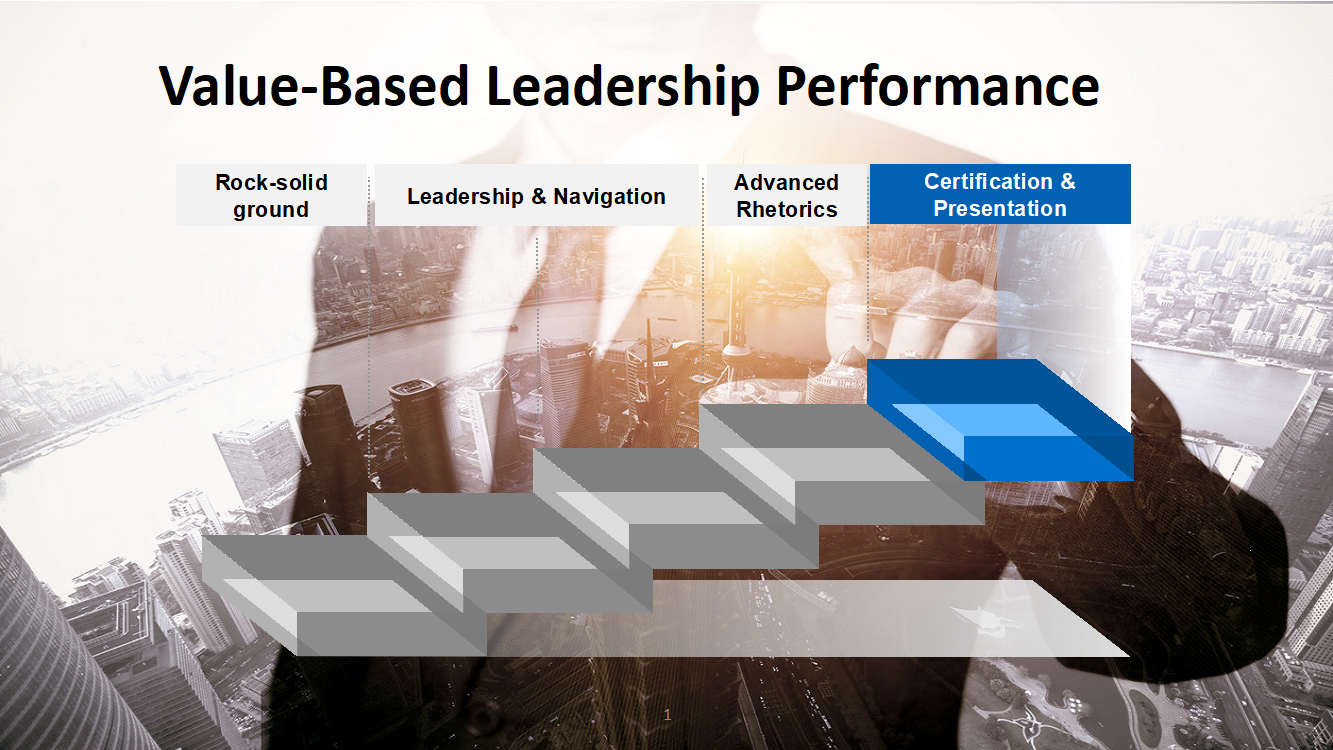
History
To own our values as a leader, we must be conscious about what we stand for, and what kind of behavior demands from us in our leadership frame. Self-knowledge is an essential key to building the self-confidence which we need at a high level. that, in turn, builds on your self-trust, abilities, and attributes.
Earlier it was all about results and not as much focus on what kind of leadership style has the biggest impact on the results long-term. Today we know so much more of the psychological benefits of leading with a larger frame of authority out in the organization. And the frame consists of feedbacking on the core values in the first place.
The evidence of developing an authentic identity based on our talents and beliefs, is the new way of leading for creating strong results in the long run.

Current Position
Even though leaders have made progress in the area, there is no doubt that there is difficult to advance up the value-based leadership ladder with an old mindset. Leaders face enormous challenges to find the vital influence which is needed in succeeding. They have less time to reflect on why they need to change their approach. So, they keep on going in old wheel tracks.
Over the last decades, the entry and benefits of value-based leadership have been crucial drivers in many organizations’ prosperity.
Significant benefits from growing the importance of reminding of where we stand, when it comes to values. However, facts tell us that continued progression is required in the area. The magnitude of these facts is preventing leaders from progressing.
It appears that many leaders are still unable to reach insights into the benefits of a strong value-based foundation. Although consciousness has improved in recent years.
Leaders in many industries continue to try to control the behavior of their employees with the carrot-and-stick method. And too many leaders struggle to balance between short-term winnings and long-term results.
Barriers to leading from equal values that promote reasonable trust in the workforce have slow progress. If these barriers persist, we will waste the potential and suffer a significant loss in our organization’s productive capacity.
According to the fact that many organizations currently use values and mission statements, individual leaders who have written down their own personal values, are still significantly less and are likely to miss out on the strong results the value-based leadership approach gives in the long run.

Future Outlook
Continued development and focus on Value-Based Leadership, would help our society and organizations, as well as the leaders themselves. However, several issues appear to be holding leaders back, including the difficulty leaders have facing priorities. When considering solutions, we should examine the benefits of establishing a strong Character matrix. Putting down such a matrix would increase leaders’ impact in the workforce, not only for their own well-being but the prosperity of the organization and our society as a whole.
With the right support, many leaders have been able to dramatically increase their score on employee surveys. By being courageous enough to follow and listen to their already wise hearts. This helps them to do the necessary work needed in the area. Which is to get clarity on what their own values are and how they can use those values to make an impact.
Empowering people to be better leaders is more vital than ever. That’s why it’s critical that we provide our future leaders with the tools they need to effectively create a change and win all the benefits of establishing a rock-solid ground built on values.. When is the best time to start investing in it? The answer to that question, you already know.
As a strong result, the culture, employee clarity, energy, productivity, influence and profitability will all be there very soon.
Executive Summary

The first workshop in our Value-Based Leadership Performance – Value-Based Leadership; focuses on Identifying and owning your own unique value as a leader, so you can present yourself with higher self-confidence and make a sustainable difference.
Although leaders today have made steps in developing themselves, many professional leaders still are not aware of the great benefits of building a rock-solid ground with a well-developed character matrix. They tend to build an armor of protection on the outside, instead of working with an inside-out approach and opening up their true self. So, they can present themselves powerfully and create vital influence on a significantly higher level. There is so much opportunity available to better support leaders in the workplace. During this workshop, we will shift our mindset and discover the power of investing in ourselves and learn how to stand in our power as a leader. This allows us to work from our heart, effectively articulate our values and make a vital difference as a leader. Where your team will follow you because of your values and the trust you show them by speaking expectations primarily from values, instead of the money point of view. The results will show up when we release the armor of protection and lead from values as a compass in our leadership model.

There are 12 focus areas in the Value-Based Leadership Workshop
Here are the areas we will cover:
1. Organization Culture – We get the culture we deserve.
Our culture is directly related to our standards. We can’t have a positive organizational culture unless we first set the standards to live up to. This implies that we must keep in mind the following: – what do we as an organization want to be known for and align with? What are our core values? What kind of behavior walks hand in hand with those core values? Why is that important? What’s the advantage of having them? What does it really mean to us?
Our potential comes from the culture we create.
Our genuine worth is found in the way we build our core values. Our potential is intangible, and a large part of it is determined by our attitude. It’s not where we currently are that decides our worth, but where we’re heading.
Knowing our core values is useless if we don’t know how to behave according to them. We must frequently communicate our core values internally and connect the values to different scenarios. By repeating them step by step, we’re building the culture on rock-solid ground in long-term.
“Act the way you want others do for you.”
Knowing your core values will benefit you and your organization, in all aspects of life. It will sharpen your behavior, both internally and externally.

2. Character Matrix – What are you known for? Is it a conscious choice? We can choose to live of external factors as excuses for our sometimes lack of behavior, or we can choose to live from a foundation built on rock, no matter what is going on around us. We are all unique, we have our own set of skills, education, and experiences. When we start getting clear on what our own core values are as a leader – and why you’ve chosen them, and the purpose is clear – then you can discover your real brilliance. People who create a conscious decision on their own brand, why they choose them and the kind of behavior that demands of them; they typically have these things in common: they’re having a strong desire to be the best they can be, they are committed to do what it takes to live up to them and have establish clarity around their actions and their results.
When we align our own core values around our gifts as humans, we will attract people around us on a significant higher level. In order, for us to implement this, we must get clear on what we truly stand for. Discover how by creating your own Character Matrix.

3. Confidence Ladder – What’s the fastest way to build confidence and trust to create strong results? What’s probably the most important thing to do first? The confidence ladder is an easy tool to use, step by step to effectively build it up. These are all desirable qualities to possess. In this course, we will learn how to use the ladder in your leadership frame, and what the traps can turn out to be. Learn the 5 steps to confidently create the trust you so desperately need in your power as a professional leader.

4. Are-Can-Do – The #1 feedback tool to take in consideration to create strong value-based leadership culture; Are-Can-Do. Where are your feedbacking from? On what circumstances? To create what? We have a way of using the first two of them too easy and unconscious. Versus taking the behavior in consideration as number one. What we see as possible, determines our success. If we see an opportunity to change for the better by using the conscious mind when giving feedback, then we are laying a more steady foundation for change. Always try to expand their possibilities for new angels and perspective, since new perspective create new opportunity.
The focus of this lesson is on using the right base to start from. To be able to transform mindset, we have to transform our use of angel to feedback from. We will learn 5 Easy Steps to increase your feedback. To be able to create a higher level of focus on the importance of value-based behavior.

5. Most Important Task – Leaders that are self-confident appear to know what to do, when to do it and how to establish a culture of create results fast. They invite people to trust them and fill them with confidence to be able to do the things they need to do, to get the result they need to get. But being aware of the most important task isn’t always simple, especially when the outside world affects us with all kind of things both important and urgent. There are steps we can take to maintain focus on the most important task, which we will cover in this course.
There is a distinct difference between those who drive towards their goals and get the results they need, and those who don’t manage to do it. It has nothing to do with time, that’s the only thing we have exactly the same amount of. We will uncover the difference. We will gain access to vital tips to help build your organization effectively.

6. Facts & Feelings – Where do you mainly make your decisions from? It can be difficult to see the difference between facts and feelings. It’s rather more normal to see feelings as facts instead of an opinion.
You probably already know this without even realizing it! However, to keep things fact based, facts and feeling must be differentiated. A feeling is not a fact and should not be used as the only evidence to support one of your decisions. Determine if there is any other evidence available. While you gain clarity on which foot you stand when making decisions, you also gain higher self-confidence to holding the line all the way. In this lesson, we will discuss the traps and the benefits of using a more conscious platform to be able to secure your long-term decision making.

7. Four S’s – One of the best return of investments you can do in life, is investing in yourself. To be aware of your status on four main areas. Self-knowledge, self-esteem, self-trust and self-confidence. It doesn’t matter if it’s about building your leadership skills, working on your relationships or personal development; we have to get to know ourselves first so we can meet the necessary requirements from others on a larger scale.
Why are the benefits of knowing where you stand in these areas so powerful?
Some of the major benefits of establishing clarity in the four S’s is so obvious; It shows that people with a high level in these four areas generally have more success at work, stronger relationships, and a significant higher mental and physical health.
It sends a powerful signal to yourself. The signal is; I’m worthy, I’m strong and I’m valuable. In this lesson, you will discover where you stand on those four areas and create your own clarity on how to strengthen them step by step.

8. Same Color On The Shirts – What does it really mean; to build a strong, well established foundation from the saying – “same color on the shirts”. It’s a well demonstrated perspective to have in mind, while you build your team and sound leadership frame. Which are recommended – to be built on core values. “SCOTS” so to say is at technique that require frequent reminding on how the “game” should be played in your organization. Who do what and when? What’s the “color” of your organizations culture and playbook?
In this lesson we will create awareness of the strong benefits of having a SCOTS mentality.

9. Attitude Indicator – Attitude is a term used in aviation to indicate the angle of the nose, which determines whether the plane will take off or land. Which is read by using an instrument called AI (Attitude Indicator). And which points upwards when the plane takes off, while the drag force is stronger than the air resistance and the lift force is greater than the weight.
Attitude is a concept that also applies to us humans, at the same time something you can control and is even more vital as a leader. We are judged based on attitude, conduct, and habitual behavior. Things that we collect under the concept of attitude. A kind of radar that sends signals to the surroundings. Whether it limits or balances us.
Being able to live life to the fullest is all about balance. About setting aside time to calibrate yourself to your morning coffee, 5 minutes a day that will change your life. People will want to work with you because of who you are, your great attitude and what you bring to the table. In this lesson, we will reveal our unique proven powerful perspective that focus on your mindset, and creates a thruster on your attitude forward.

10. Setting Large Frames – Setting boundaries is essential to maintain a stable value-based leadership frame. Frameworks for responsibility and authority to make decisions. Have you established clarity for your organization in that area? Have you thought about the benefits that follow by doing it?
In this lesson, we will identify the benefits of a clear and safe framework. So we effectively can manage our time to create strong results faster. We will also go through how this frame should align with your core values. Firm boundaries that spreads and benefits creativity in your organization.

11. Key Value Performers – When we hear the word “key performers”, we may think of the people who has the most influence over the organization’s revenue. The question is; are they also in alignment and acting as role models for your core values. Key value performers? As a leader you will need all the help you can get, to establish a value-based leadership. One of the main things to take in consideration, is to find, and train, some of your co-workers to become the flag bearer for your core values = key value performers.
The benefits of searching and training your “KVP’s”, is that hardly anything can shake the foundation of the core values that you built your organization on. In this lesson, you will discover what and how to look for them, so you confidently can stand in your power as the professional and capable leader you already are.

12. Value Line – In this last lesson, we will run some vital statements to get a value meter on the opinions of your team. One person’s negative perspective on some of the statements may affect the attitude of the whole group, with the risk of razing the organizations value-based foundation. It’s all too easy to neglect the attitude of your co-workers, which tend to drain you and your organization of energy long-term. The benefit by using a value line bases on vital statements, is that it reveals the perspective of your teams on important matters. You’ll also have the possibility to create consensus on your core values, and how they can see it from different angels. In this final course of the workshop, you will discover how to Activate Your teams consensus and behavior, which will tremendously help you establish a strong consensus from your values point of view.
Impact for strengthen the value-base
As Summary of every workshop, we focus on how you, as a leader, will use what we’ve learned into practice in your organization. Impact for strengthen the value base not only requires putting what you’ve learned into practice but also taking action to make a significant difference. How can you involve people in your organization and ask/request what you need from them in order to succeed. Not only will your team be involved, the engagement for a value-based organization will improve drastically. How would you collaborate to ensure that people in your company have the insight they need to make you as a team succeed?
Curriculum
Value-Based Leadership Performance – Workshop 1 – Value-Based Leadership
- Organization Culture(OC)
- Character Matrix (CM)
- Confidence Ladder (CL)
- Are-Can-Do (ACD)
- Most Important Task (MIT)
- Facts & Feelings (F&F)
- Four S’s (4*S)
- ”Same Color of The Shirts” (SCOTS)
- Attitude Indicator (AI)
- Setting Large Frames (SLF)
- Key Value Performers (KVP)
- Value Line (VL)
Distance Learning
Introduction
Welcome to Appleton Greene and thank you for enrolling on the Value-Based Leadership Performance corporate training program. You will be learning through our unique facilitation via distance-learning method, which will enable you to practically implement everything that you learn academically. The methods and materials used in your program have been designed and developed to ensure that you derive the maximum benefits and enjoyment possible. We hope that you find the program challenging and fun to do. However, if you have never been a distance-learner before, you may be experiencing some trepidation at the task before you. So we will get you started by giving you some basic information and guidance on how you can make the best use of the modules, how you should manage the materials and what you should be doing as you work through them. This guide is designed to point you in the right direction and help you to become an effective distance-learner. Take a few hours or so to study this guide and your guide to tutorial support for students, while making notes, before you start to study in earnest.
Study environment
You will need to locate a quiet and private place to study, preferably a room where you can easily be isolated from external disturbances or distractions. Make sure the room is well-lit and incorporates a relaxed, pleasant feel. If you can spoil yourself within your study environment, you will have much more of a chance to ensure that you are always in the right frame of mind when you do devote time to study. For example, a nice fire, the ability to play soft soothing background music, soft but effective lighting, perhaps a nice view if possible and a good size desk with a comfortable chair. Make sure that your family know when you are studying and understand your study rules. Your study environment is very important. The ideal situation, if at all possible, is to have a separate study, which can be devoted to you. If this is not possible then you will need to pay a lot more attention to developing and managing your study schedule, because it will affect other people as well as yourself. The better your study environment, the more productive you will be.
Study tools & rules
Try and make sure that your study tools are sufficient and in good working order. You will need to have access to a computer, scanner and printer, with access to the internet. You will need a very comfortable chair, which supports your lower back, and you will need a good filing system. It can be very frustrating if you are spending valuable study time trying to fix study tools that are unreliable, or unsuitable for the task. Make sure that your study tools are up to date. You will also need to consider some study rules. Some of these rules will apply to you and will be intended to help you to be more disciplined about when and how you study. This distance-learning guide will help you and after you have read it you can put some thought into what your study rules should be. You will also need to negotiate some study rules for your family, friends or anyone who lives with you. They too will need to be disciplined in order to ensure that they can support you while you study. It is important to ensure that your family and friends are an integral part of your study team. Having their support and encouragement can prove to be a crucial contribution to your successful completion of the program. Involve them in as much as you can.
Successful distance-learning
Distance-learners are freed from the necessity of attending regular classes or workshops, since they can study in their own way, at their own pace and for their own purposes. But unlike traditional internal training courses, it is the student’s responsibility, with a distance-learning program, to ensure that they manage their own study contribution. This requires strong self-discipline and self-motivation skills and there must be a clear will to succeed. Those students who are used to managing themselves, are good at managing others and who enjoy working in isolation, are more likely to be good distance-learners. It is also important to be aware of the main reasons why you are studying and of the main objectives that you are hoping to achieve as a result. You will need to remind yourself of these objectives at times when you need to motivate yourself. Never lose sight of your long-term goals and your short-term objectives. There is nobody available here to pamper you, or to look after you, or to spoon-feed you with information, so you will need to find ways to encourage and appreciate yourself while you are studying. Make sure that you chart your study progress, so that you can be sure of your achievements and re-evaluate your goals and objectives regularly.
Self-assessment
Appleton Greene training programs are in all cases post-graduate programs. Consequently, you should already have obtained a business-related degree and be an experienced learner. You should therefore already be aware of your study strengths and weaknesses. For example, which time of the day are you at your most productive? Are you a lark or an owl? What study methods do you respond to the most? Are you a consistent learner? How do you discipline yourself? How do you ensure that you enjoy yourself while studying? It is important to understand yourself as a learner and so some self-assessment early on will be necessary if you are to apply yourself correctly. Perform a SWOT analysis on yourself as a student. List your internal strengths and weaknesses as a student and your external opportunities and threats. This will help you later on when you are creating a study plan. You can then incorporate features within your study plan that can ensure that you are playing to your strengths, while compensating for your weaknesses. You can also ensure that you make the most of your opportunities, while avoiding the potential threats to your success.
Accepting responsibility as a student
Training programs invariably require a significant investment, both in terms of what they cost and in the time that you need to contribute to study and the responsibility for successful completion of training programs rests entirely with the student. This is never more apparent than when a student is learning via distance-learning. Accepting responsibility as a student is an important step towards ensuring that you can successfully complete your training program. It is easy to instantly blame other people or factors when things go wrong. But the fact of the matter is that if a failure is your failure, then you have the power to do something about it, it is entirely in your own hands. If it is always someone else’s failure, then you are powerless to do anything about it. All students study in entirely different ways, this is because we are all individuals and what is right for one student, is not necessarily right for another. In order to succeed, you will have to accept personal responsibility for finding a way to plan, implement and manage a personal study plan that works for you. If you do not succeed, you only have yourself to blame.
Planning
By far the most critical contribution to stress, is the feeling of not being in control. In the absence of planning we tend to be reactive and can stumble from pillar to post in the hope that things will turn out fine in the end. Invariably they don’t! In order to be in control, we need to have firm ideas about how and when we want to do things. We also need to consider as many possible eventualities as we can, so that we are prepared for them when they happen. Prescriptive Change, is far easier to manage and control, than Emergent Change. The same is true with distance-learning. It is much easier and much more enjoyable, if you feel that you are in control and that things are going to plan. Even when things do go wrong, you are prepared for them and can act accordingly without any unnecessary stress. It is important therefore that you do take time to plan your studies properly.
Management
Once you have developed a clear study plan, it is of equal importance to ensure that you manage the implementation of it. Most of us usually enjoy planning, but it is usually during implementation when things go wrong. Targets are not met and we do not understand why. Sometimes we do not even know if targets are being met. It is not enough for us to conclude that the study plan just failed. If it is failing, you will need to understand what you can do about it. Similarly if your study plan is succeeding, it is still important to understand why, so that you can improve upon your success. You therefore need to have guidelines for self-assessment so that you can be consistent with performance improvement throughout the program. If you manage things correctly, then your performance should constantly improve throughout the program.
Study objectives & tasks
The first place to start is developing your program objectives. These should feature your reasons for undertaking the training program in order of priority. Keep them succinct and to the point in order to avoid confusion. Do not just write the first things that come into your head because they are likely to be too similar to each other. Make a list of possible departmental headings, such as: Customer Service; E-business; Finance; Globalization; Human Resources; Technology; Legal; Management; Marketing and Production. Then brainstorm for ideas by listing as many things that you want to achieve under each heading and later re-arrange these things in order of priority. Finally, select the top item from each department heading and choose these as your program objectives. Try and restrict yourself to five because it will enable you to focus clearly. It is likely that the other things that you listed will be achieved if each of the top objectives are achieved. If this does not prove to be the case, then simply work through the process again.
Study forecast
As a guide, the Appleton Greene Value-Based Leadership Performance corporate training program should take 12-18 months to complete, depending upon your availability and current commitments. The reason why there is such a variance in time estimates is because every student is an individual, with differing productivity levels and different commitments. These differentiations are then exaggerated by the fact that this is a distance-learning program, which incorporates the practical integration of academic theory as an as a part of the training program. Consequently all of the project studies are real, which means that important decisions and compromises need to be made. You will want to get things right and will need to be patient with your expectations in order to ensure that they are. We would always recommend that you are prudent with your own task and time forecasts, but you still need to develop them and have a clear indication of what are realistic expectations in your case. With reference to your time planning: consider the time that you can realistically dedicate towards study with the program every week; calculate how long it should take you to complete the program, using the guidelines featured here; then break the program down into logical modules and allocate a suitable proportion of time to each of them, these will be your milestones; you can create a time plan by using a spreadsheet on your computer, or a personal organizer such as MS Outlook, you could also use a financial forecasting software; break your time forecasts down into manageable chunks of time, the more specific you can be, the more productive and accurate your time management will be; finally, use formulas where possible to do your time calculations for you, because this will help later on when your forecasts need to change in line with actual performance. With reference to your task planning: refer to your list of tasks that need to be undertaken in order to achieve your program objectives; with reference to your time plan, calculate when each task should be implemented; remember that you are not estimating when your objectives will be achieved, but when you will need to focus upon implementing the corresponding tasks; you also need to ensure that each task is implemented in conjunction with the associated training modules which are relevant; then break each single task down into a list of specific to do’s, say approximately ten to do’s for each task and enter these into your study plan; once again you could use MS Outlook to incorporate both your time and task planning and this could constitute your study plan; you could also use a project management software like MS Project. You should now have a clear and realistic forecast detailing when you can expect to be able to do something about undertaking the tasks to achieve your program objectives.
Performance management
It is one thing to develop your study forecast, it is quite another to monitor your progress. Ultimately it is less important whether you achieve your original study forecast and more important that you update it so that it constantly remains realistic in line with your performance. As you begin to work through the program, you will begin to have more of an idea about your own personal performance and productivity levels as a distance-learner. Once you have completed your first study module, you should re-evaluate your study forecast for both time and tasks, so that they reflect your actual performance level achieved. In order to achieve this you must first time yourself while training by using an alarm clock. Set the alarm for hourly intervals and make a note of how far you have come within that time. You can then make a note of your actual performance on your study plan and then compare your performance against your forecast. Then consider the reasons that have contributed towards your performance level, whether they are positive or negative and make a considered adjustment to your future forecasts as a result. Given time, you should start achieving your forecasts regularly.
With reference to time management: time yourself while you are studying and make a note of the actual time taken in your study plan; consider your successes with time-efficiency and the reasons for the success in each case and take this into consideration when reviewing future time planning; consider your failures with time-efficiency and the reasons for the failures in each case and take this into consideration when reviewing future time planning; re-evaluate your study forecast in relation to time planning for the remainder of your training program to ensure that you continue to be realistic about your time expectations. You need to be consistent with your time management, otherwise you will never complete your studies. This will either be because you are not contributing enough time to your studies, or you will become less efficient with the time that you do allocate to your studies. Remember, if you are not in control of your studies, they can just become yet another cause of stress for you.
With reference to your task management: time yourself while you are studying and make a note of the actual tasks that you have undertaken in your study plan; consider your successes with task-efficiency and the reasons for the success in each case; take this into consideration when reviewing future task planning; consider your failures with task-efficiency and the reasons for the failures in each case and take this into consideration when reviewing future task planning; re-evaluate your study forecast in relation to task planning for the remainder of your training program to ensure that you continue to be realistic about your task expectations. You need to be consistent with your task management, otherwise you will never know whether you are achieving your program objectives or not.
Keeping in touch
You will have access to qualified and experienced professors and tutors who are responsible for providing tutorial support for your particular training program. So don’t be shy about letting them know how you are getting on. We keep electronic records of all tutorial support emails so that professors and tutors can review previous correspondence before considering an individual response. It also means that there is a record of all communications between you and your professors and tutors and this helps to avoid any unnecessary duplication, misunderstanding, or misinterpretation. If you have a problem relating to the program, share it with them via email. It is likely that they have come across the same problem before and are usually able to make helpful suggestions and steer you in the right direction. To learn more about when and how to use tutorial support, please refer to the Tutorial Support section of this student information guide. This will help you to ensure that you are making the most of tutorial support that is available to you and will ultimately contribute towards your success and enjoyment with your training program.
Work colleagues and family
You should certainly discuss your program study progress with your colleagues, friends and your family. Appleton Greene training programs are very practical. They require you to seek information from other people, to plan, develop and implement processes with other people and to achieve feedback from other people in relation to viability and productivity. You will therefore have plenty of opportunities to test your ideas and enlist the views of others. People tend to be sympathetic towards distance-learners, so don’t bottle it all up in yourself. Get out there and share it! It is also likely that your family and colleagues are going to benefit from your labors with the program, so they are likely to be much more interested in being involved than you might think. Be bold about delegating work to those who might benefit themselves. This is a great way to achieve understanding and commitment from people who you may later rely upon for process implementation. Share your experiences with your friends and family.
Making it relevant
The key to successful learning is to make it relevant to your own individual circumstances. At all times you should be trying to make bridges between the content of the program and your own situation. Whether you achieve this through quiet reflection or through interactive discussion with your colleagues, client partners or your family, remember that it is the most important and rewarding aspect of translating your studies into real self-improvement. You should be clear about how you want the program to benefit you. This involves setting clear study objectives in relation to the content of the course in terms of understanding, concepts, completing research or reviewing activities and relating the content of the modules to your own situation. Your objectives may understandably change as you work through the program, in which case you should enter the revised objectives on your study plan so that you have a permanent reminder of what you are trying to achieve, when and why.
Distance-learning check-list
Prepare your study environment, your study tools and rules.
Undertake detailed self-assessment in terms of your ability as a learner.
Create a format for your study plan.
Consider your study objectives and tasks.
Create a study forecast.
Assess your study performance.
Re-evaluate your study forecast.
Be consistent when managing your study plan.
Use your Appleton Greene Certified Learning Provider (CLP) for tutorial support.
Make sure you keep in touch with those around you.

Tutorial Support
Programs
Appleton Greene uses standard and bespoke corporate training programs as vessels to transfer business process improvement knowledge into the heart of our clients’ organizations. Each individual program focuses upon the implementation of a specific business process, which enables clients to easily quantify their return on investment. There are hundreds of established Appleton Greene corporate training products now available to clients within customer services, e-business, finance, globalization, human resources, information technology, legal, management, marketing and production. It does not matter whether a client’s employees are located within one office, or an unlimited number of international offices, we can still bring them together to learn and implement specific business processes collectively. Our approach to global localization enables us to provide clients with a truly international service with that all important personal touch. Appleton Greene corporate training programs can be provided virtually or locally and they are all unique in that they individually focus upon a specific business function. They are implemented over a sustainable period of time and professional support is consistently provided by qualified learning providers and specialist consultants.
Support available
You will have a designated Certified Learning Provider (CLP) and an Accredited Consultant and we encourage you to communicate with them as much as possible. In all cases tutorial support is provided online because we can then keep a record of all communications to ensure that tutorial support remains consistent. You would also be forwarding your work to the tutorial support unit for evaluation and assessment. You will receive individual feedback on all of the work that you undertake on a one-to-one basis, together with specific recommendations for anything that may need to be changed in order to achieve a pass with merit or a pass with distinction and you then have as many opportunities as you may need to re-submit project studies until they meet with the required standard. Consequently the only reason that you should really fail (CLP) is if you do not do the work. It makes no difference to us whether a student takes 12 months or 18 months to complete the program, what matters is that in all cases the same quality standard will have been achieved.
Support Process
Please forward all of your future emails to the designated (CLP) Tutorial Support Unit email address that has been provided and please do not duplicate or copy your emails to other AGC email accounts as this will just cause unnecessary administration. Please note that emails are always answered as quickly as possible but you will need to allow a period of up to 20 business days for responses to general tutorial support emails during busy periods, because emails are answered strictly within the order in which they are received. You will also need to allow a period of up to 30 business days for the evaluation and assessment of project studies. This does not include weekends or public holidays. Please therefore kindly allow for this within your time planning. All communications are managed online via email because it enables tutorial service support managers to review other communications which have been received before responding and it ensures that there is a copy of all communications retained on file for future reference. All communications will be stored within your personal (CLP) study file here at Appleton Greene throughout your designated study period. If you need any assistance or clarification at any time, please do not hesitate to contact us by forwarding an email and remember that we are here to help. If you have any questions, please list and number your questions succinctly and you can then be sure of receiving specific answers to each and every query.
Time Management
It takes approximately 1 Year to complete the Value-Based Leadership Performance corporate training program, incorporating 12 x 6-hour monthly workshops. Each student will also need to contribute approximately 4 hours per week over 1 Year of their personal time. Students can study from home or work at their own pace and are responsible for managing their own study plan. There are no formal examinations and students are evaluated and assessed based upon their project study submissions, together with the quality of their internal analysis and supporting documents. They can contribute more time towards study when they have the time to do so and can contribute less time when they are busy. All students tend to be in full time employment while studying and the Value-Based Leadership Performance program is purposely designed to accommodate this, so there is plenty of flexibility in terms of time management. It makes no difference to us at Appleton Greene, whether individuals take 12-18 months to complete this program. What matters is that in all cases the same standard of quality will have been achieved with the standard and bespoke programs that have been developed.
Distance Learning Guide
The distance learning guide should be your first port of call when starting your training program. It will help you when you are planning how and when to study, how to create the right environment and how to establish the right frame of mind. If you can lay the foundations properly during the planning stage, then it will contribute to your enjoyment and productivity while training later. The guide helps to change your lifestyle in order to accommodate time for study and to cultivate good study habits. It helps you to chart your progress so that you can measure your performance and achieve your goals. It explains the tools that you will need for study and how to make them work. It also explains how to translate academic theory into practical reality. Spend some time now working through your distance learning guide and make sure that you have firm foundations in place so that you can make the most of your distance learning program. There is no requirement for you to attend training workshops or classes at Appleton Greene offices. The entire program is undertaken online, program course manuals and project studies are administered via the Appleton Greene web site and via email, so you are able to study at your own pace and in the comfort of your own home or office as long as you have a computer and access to the internet.
How To Study
The how to study guide provides students with a clear understanding of the Appleton Greene facilitation via distance learning training methods and enables students to obtain a clear overview of the training program content. It enables students to understand the step-by-step training methods used by Appleton Greene and how course manuals are integrated with project studies. It explains the research and development that is required and the need to provide evidence and references to support your statements. It also enables students to understand precisely what will be required of them in order to achieve a pass with merit and a pass with distinction for individual project studies and provides useful guidance on how to be innovative and creative when developing your Unique Program Proposition (UPP).
Tutorial Support
Tutorial support for the Appleton Greene Value-Based Leadership Performance corporate training program is provided online either through the Appleton Greene Client Support Portal (CSP), or via email. All tutorial support requests are facilitated by a designated Program Administration Manager (PAM). They are responsible for deciding which professor or tutor is the most appropriate option relating to the support required and then the tutorial support request is forwarded onto them. Once the professor or tutor has completed the tutorial support request and answered any questions that have been asked, this communication is then returned to the student via email by the designated Program Administration Manager (PAM). This enables all tutorial support, between students, professors and tutors, to be facilitated by the designated Program Administration Manager (PAM) efficiently and securely through the email account. You will therefore need to allow a period of up to 20 business days for responses to general support queries and up to 30 business days for the evaluation and assessment of project studies, because all tutorial support requests are answered strictly within the order in which they are received. This does not include weekends or public holidays. Consequently you need to put some thought into the management of your tutorial support procedure in order to ensure that your study plan is feasible and to obtain the maximum possible benefit from tutorial support during your period of study. Please retain copies of your tutorial support emails for future reference. Please ensure that ALL of your tutorial support emails are set out using the format as suggested within your guide to tutorial support. Your tutorial support emails need to be referenced clearly to the specific part of the course manual or project study which you are working on at any given time. You also need to list and number any questions that you would like to ask, up to a maximum of five questions within each tutorial support email. Remember the more specific you can be with your questions the more specific your answers will be too and this will help you to avoid any unnecessary misunderstanding, misinterpretation, or duplication. The guide to tutorial support is intended to help you to understand how and when to use support in order to ensure that you get the most out of your training program. Appleton Greene training programs are designed to enable you to do things for yourself. They provide you with a structure or a framework and we use tutorial support to facilitate students while they practically implement what they learn. In other words, we are enabling students to do things for themselves. The benefits of distance learning via facilitation are considerable and are much more sustainable in the long-term than traditional short-term knowledge sharing programs. Consequently you should learn how and when to use tutorial support so that you can maximize the benefits from your learning experience with Appleton Greene. This guide describes the purpose of each training function and how to use them and how to use tutorial support in relation to each aspect of the training program. It also provides useful tips and guidance with regard to best practice.
Tutorial Support Tips
Students are often unsure about how and when to use tutorial support with Appleton Greene. This Tip List will help you to understand more about how to achieve the most from using tutorial support. Refer to it regularly to ensure that you are continuing to use the service properly. Tutorial support is critical to the success of your training experience, but it is important to understand when and how to use it in order to maximize the benefit that you receive. It is no coincidence that those students who succeed are those that learn how to be positive, proactive and productive when using tutorial support.
Be positive and friendly with your tutorial support emails
Remember that if you forward an email to the tutorial support unit, you are dealing with real people. “Do unto others as you would expect others to do unto you”. If you are positive, complimentary and generally friendly in your emails, you will generate a similar response in return. This will be more enjoyable, productive and rewarding for you in the long-term.
Think about the impression that you want to create
Every time that you communicate, you create an impression, which can be either positive or negative, so put some thought into the impression that you want to create. Remember that copies of all tutorial support emails are stored electronically and tutors will always refer to prior correspondence before responding to any current emails. Over a period of time, a general opinion will be arrived at in relation to your character, attitude and ability. Try to manage your own frustrations, mood swings and temperament professionally, without involving the tutorial support team. Demonstrating frustration or a lack of patience is a weakness and will be interpreted as such. The good thing about communicating in writing, is that you will have the time to consider your content carefully, you can review it and proof-read it before sending your email to Appleton Greene and this should help you to communicate more professionally, consistently and to avoid any unnecessary knee-jerk reactions to individual situations as and when they may arise. Please also remember that the CLP Tutorial Support Unit will not just be responsible for evaluating and assessing the quality of your work, they will also be responsible for providing recommendations to other learning providers and to client contacts within the Appleton Greene global client network, so do be in control of your own emotions and try to create a good impression.
Remember that quality is preferred to quantity
Please remember that when you send an email to the tutorial support team, you are not using Twitter or Text Messaging. Try not to forward an email every time that you have a thought. This will not prove to be productive either for you or for the tutorial support team. Take time to prepare your communications properly, as if you were writing a professional letter to a business colleague and make a list of queries that you are likely to have and then incorporate them within one email, say once every month, so that the tutorial support team can understand more about context, application and your methodology for study. Get yourself into a consistent routine with your tutorial support requests and use the tutorial support template provided with ALL of your emails. The (CLP) Tutorial Support Unit will not spoon-feed you with information. They need to be able to evaluate and assess your tutorial support requests carefully and professionally.
Be specific about your questions in order to receive specific answers
Try not to write essays by thinking as you are writing tutorial support emails. The tutorial support unit can be unclear about what in fact you are asking, or what you are looking to achieve. Be specific about asking questions that you want answers to. Number your questions. You will then receive specific answers to each and every question. This is the main purpose of tutorial support via email.
Keep a record of your tutorial support emails
It is important that you keep a record of all tutorial support emails that are forwarded to you. You can then refer to them when necessary and it avoids any unnecessary duplication, misunderstanding, or misinterpretation.
Individual training workshops or telephone support
Please be advised that Appleton Greene does not provide separate or individual tutorial support meetings, workshops, or provide telephone support for individual students. Appleton Greene is an equal opportunities learning and service provider and we are therefore understandably bound to treat all students equally. We cannot therefore broker special financial or study arrangements with individual students regardless of the circumstances. All tutorial support is provided online and this enables Appleton Greene to keep a record of all communications between students, professors and tutors on file for future reference, in accordance with our quality management procedure and your terms and conditions of enrolment. All tutorial support is provided online via email because it enables us to have time to consider support content carefully, it ensures that you receive a considered and detailed response to your queries. You can number questions that you would like to ask, which relate to things that you do not understand or where clarification may be required. You can then be sure of receiving specific answers to each individual query. You will also then have a record of these communications and of all tutorial support, which has been provided to you. This makes tutorial support administration more productive by avoiding any unnecessary duplication, misunderstanding, or misinterpretation.
Tutorial Support Email Format
You should use this tutorial support format if you need to request clarification or assistance while studying with your training program. Please note that ALL of your tutorial support request emails should use the same format. You should therefore set up a standard email template, which you can then use as and when you need to. Emails that are forwarded to Appleton Greene, which do not use the following format, may be rejected and returned to you by the (CLP) Program Administration Manager. A detailed response will then be forwarded to you via email usually within 20 business days of receipt for general support queries and 30 business days for the evaluation and assessment of project studies. This does not include weekends or public holidays. Your tutorial support request, together with the corresponding TSU reply, will then be saved and stored within your electronic TSU file at Appleton Greene for future reference.
Subject line of your email
Please insert: Appleton Greene (CLP) Tutorial Support Request: (Your Full Name) (Date), within the subject line of your email.
Main body of your email
Please insert:
1. Appleton Greene Certified Learning Provider (CLP) Tutorial Support Request
2. Your Full Name
3. Date of TS request
4. Preferred email address
5. Backup email address
6. Course manual page name or number (reference)
7. Project study page name or number (reference)
Subject of enquiry
Please insert a maximum of 50 words (please be succinct)
Briefly outline the subject matter of your inquiry, or what your questions relate to.
Question 1
Maximum of 50 words (please be succinct)
Maximum of 50 words (please be succinct)
Question 3
Maximum of 50 words (please be succinct)
Question 4
Maximum of 50 words (please be succinct)
Question 5
Maximum of 50 words (please be succinct)
Please note that a maximum of 5 questions is permitted with each individual tutorial support request email.
Procedure
* List the questions that you want to ask first, then re-arrange them in order of priority. Make sure that you reference them, where necessary, to the course manuals or project studies.
* Make sure that you are specific about your questions and number them. Try to plan the content within your emails to make sure that it is relevant.
* Make sure that your tutorial support emails are set out correctly, using the Tutorial Support Email Format provided here.
* Save a copy of your email and incorporate the date sent after the subject title. Keep your tutorial support emails within the same file and in date order for easy reference.
* Allow up to 20 business days for a response to general tutorial support emails and up to 30 business days for the evaluation and assessment of project studies, because detailed individual responses will be made in all cases and tutorial support emails are answered strictly within the order in which they are received.
* Emails can and do get lost. So if you have not received a reply within the appropriate time, forward another copy or a reminder to the tutorial support unit to be sure that it has been received but do not forward reminders unless the appropriate time has elapsed.
* When you receive a reply, save it immediately featuring the date of receipt after the subject heading for easy reference. In most cases the tutorial support unit replies to your questions individually, so you will have a record of the questions that you asked as well as the answers offered. With project studies however, separate emails are usually forwarded by the tutorial support unit, so do keep a record of your own original emails as well.
* Remember to be positive and friendly in your emails. You are dealing with real people who will respond to the same things that you respond to.
* Try not to repeat questions that have already been asked in previous emails. If this happens the tutorial support unit will probably just refer you to the appropriate answers that have already been provided within previous emails.
* If you lose your tutorial support email records you can write to Appleton Greene to receive a copy of your tutorial support file, but a separate administration charge may be levied for this service.

How To Study
Your Certified Learning Provider (CLP) and Accredited Consultant can help you to plan a task list for getting started so that you can be clear about your direction and your priorities in relation to your training program. It is also a good way to introduce yourself to the tutorial support team.
Planning your study environment
Your study conditions are of great importance and will have a direct effect on how much you enjoy your training program. Consider how much space you will have, whether it is comfortable and private and whether you are likely to be disturbed. The study tools and facilities at your disposal are also important to the success of your distance-learning experience. Your tutorial support unit can help with useful tips and guidance, regardless of your starting position. It is important to get this right before you start working on your training program.
Planning your program objectives
It is important that you have a clear list of study objectives, in order of priority, before you start working on your training program. Your tutorial support unit can offer assistance here to ensure that your study objectives have been afforded due consideration and priority.
Planning how and when to study
Distance-learners are freed from the necessity of attending regular classes, since they can study in their own way, at their own pace and for their own purposes. This approach is designed to let you study efficiently away from the traditional classroom environment. It is important however, that you plan how and when to study, so that you are making the most of your natural attributes, strengths and opportunities. Your tutorial support unit can offer assistance and useful tips to ensure that you are playing to your strengths.
Planning your study tasks
You should have a clear understanding of the study tasks that you should be undertaking and the priority associated with each task. These tasks should also be integrated with your program objectives. The distance learning guide and the guide to tutorial support for students should help you here, but if you need any clarification or assistance, please contact your tutorial support unit.
Planning your time
You will need to allocate specific times during your calendar when you intend to study if you are to have a realistic chance of completing your program on time. You are responsible for planning and managing your own study time, so it is important that you are successful with this. Your tutorial support unit can help you with this if your time plan is not working.
Keeping in touch
Consistency is the key here. If you communicate too frequently in short bursts, or too infrequently with no pattern, then your management ability with your studies will be questioned, both by you and by your tutorial support unit. It is obvious when a student is in control and when one is not and this will depend how able you are at sticking with your study plan. Inconsistency invariably leads to in-completion.
Charting your progress
Your tutorial support team can help you to chart your own study progress. Refer to your distance learning guide for further details.
Making it work
To succeed, all that you will need to do is apply yourself to undertaking your training program and interpreting it correctly. Success or failure lies in your hands and your hands alone, so be sure that you have a strategy for making it work. Your Certified Learning Provider (CLP) and Accredited Consultant can guide you through the process of program planning, development and implementation.
Reading methods
Interpretation is often unique to the individual but it can be improved and even quantified by implementing consistent interpretation methods. Interpretation can be affected by outside interference such as family members, TV, or the Internet, or simply by other thoughts which are demanding priority in our minds. One thing that can improve our productivity is using recognized reading methods. This helps us to focus and to be more structured when reading information for reasons of importance, rather than relaxation.
Speed reading
When reading through course manuals for the first time, subconsciously set your reading speed to be just fast enough that you cannot dwell on individual words or tables. With practice, you should be able to read an A4 sheet of paper in one minute. You will not achieve much in the way of a detailed understanding, but your brain will retain a useful overview. This overview will be important later on and will enable you to keep individual issues in perspective with a more generic picture because speed reading appeals to the memory part of the brain. Do not worry about what you do or do not remember at this stage.
Content reading
Once you have speed read everything, you can then start work in earnest. You now need to read a particular section of your course manual thoroughly, by making detailed notes while you read. This process is called Content Reading and it will help to consolidate your understanding and interpretation of the information that has been provided.
Making structured notes on the course manuals
When you are content reading, you should be making detailed notes, which are both structured and informative. Make these notes in a MS Word document on your computer, because you can then amend and update these as and when you deem it to be necessary. List your notes under three headings: 1. Interpretation – 2. Questions – 3. Tasks. The purpose of the 1st section is to clarify your interpretation by writing it down. The purpose of the 2nd section is to list any questions that the issue raises for you. The purpose of the 3rd section is to list any tasks that you should undertake as a result. Anyone who has graduated with a business-related degree should already be familiar with this process.
Organizing structured notes separately
You should then transfer your notes to a separate study notebook, preferably one that enables easy referencing, such as a MS Word Document, a MS Excel Spreadsheet, a MS Access Database, or a personal organizer on your cell phone. Transferring your notes allows you to have the opportunity of cross-checking and verifying them, which assists considerably with understanding and interpretation. You will also find that the better you are at doing this, the more chance you will have of ensuring that you achieve your study objectives.
Question your understanding
Do challenge your understanding. Explain things to yourself in your own words by writing things down.
Clarifying your understanding
If you are at all unsure, forward an email to your tutorial support unit and they will help to clarify your understanding.
Question your interpretation
Do challenge your interpretation. Qualify your interpretation by writing it down.
Clarifying your interpretation
If you are at all unsure, forward an email to your tutorial support unit and they will help to clarify your interpretation.
Qualification Requirements
The student will need to successfully complete the project study and all of the exercises relating to the Value-Based Leadership Performance corporate training program, achieving a pass with merit or distinction in each case, in order to qualify as an Accredited Value-Based Leadership Performance Specialist (AVBLPS). All monthly workshops need to be tried and tested within your company. These project studies can be completed in your own time and at your own pace and in the comfort of your own home or office. There are no formal examinations, assessment is based upon the successful completion of the project studies. They are called project studies because, unlike case studies, these projects are not theoretical, they incorporate real program processes that need to be properly researched and developed. The project studies assist us in measuring your understanding and interpretation of the training program and enable us to assess qualification merits. All of the project studies are based entirely upon the content within the training program and they enable you to integrate what you have learnt into your corporate training practice.
Value-Based Leadership Performance – Grading Contribution
Project Study – Grading Contribution
Customer Service – 10%
E-business – 05%
Finance – 10%
Globalization – 10%
Human Resources – 10%
Information Technology – 10%
Legal – 05%
Management – 10%
Marketing – 10%
Production – 10%
Education – 05%
Logistics – 05%
TOTAL GRADING – 100%
Qualification grades
A mark of 90% = Pass with Distinction.
A mark of 75% = Pass with Merit.
A mark of less than 75% = Fail.
If you fail to achieve a mark of 75% with a project study, you will receive detailed feedback from the Certified Learning Provider (CLP) and/or Accredited Consultant, together with a list of tasks which you will need to complete, in order to ensure that your project study meets with the minimum quality standard that is required by Appleton Greene. You can then re-submit your project study for further evaluation and assessment. Indeed you can re-submit as many drafts of your project studies as you need to, until such a time as they eventually meet with the required standard by Appleton Greene, so you need not worry about this, it is all part of the learning process.
When marking project studies, Appleton Greene is looking for sufficient evidence of the following:
Pass with merit
A satisfactory level of program understanding
A satisfactory level of program interpretation
A satisfactory level of project study content presentation
A satisfactory level of Unique Program Proposition (UPP) quality
A satisfactory level of the practical integration of academic theory
Pass with distinction
An exceptional level of program understanding
An exceptional level of program interpretation
An exceptional level of project study content presentation
An exceptional level of Unique Program Proposition (UPP) quality
An exceptional level of the practical integration of academic theory
Preliminary Analysis
TO BE ADVISED
Course Manuals 1-12

Course Manual 1: Organization Culture
We get the culture we deserve.
Our culture is directly related to our standards. We can’t have a positive organizational culture unless we first set the standards to live up to. This implies that we must keep in mind the following: – what do we as an organization want to be known for and align with? What are our core values? What kind of behavior walks hand in hand with those core values? Why is that important? What’s the advantage of having them? What does it really mean to us?
Our potential comes from the culture we create.
Our genuine worth is found in the way we build our core values. Our potential is intangible, and a large part of it is determined by our attitude. It’s not where we currently are that decides our worth, but where we’re heading.
Knowing our core values is useless if we don’t know how to behave according to them. We must frequently communicate our core values internally and connect the values to different scenarios. By repeating them step by step, we’re building the culture on rock-solid ground in long-term.

“We are where we are because of our habits. Let us state that. Whether good or bad, they control our lives”

Exercise 1:1 – Curse of knowledge
1. Fold the paper in half
2. Fold it in half again
3. Tear off the upper right corner
4. Unfold the paper once
5. Then fold it the other way
6. Tear off both upper corners
7. Unfold the whole paper, you can now open your eyes, and hold it up for all to see
8. All papers should now look exactly the same
Values

Value-Base is an established concept that encompasses the basic values that shape an organization’s norms and actions, a collective term for questions about morality, ethics, relationships, democracy, and outlook on life.
It may sound obvious, but the fact is that there are very few companies that let the values permeate everything they do.
What happens when you let values rule? Well, partly it creates a higher sense of meaning and a greater sense of commitment. In addition, it becomes clear where you are going, which provides security and belonging. And because you work based on a common purpose, the WE feeling increases and the team becomes more important. If you succeed, you do it “together.”
Most organizations have established values and a mission statement today. But quite a few have done the job required with them.
The challenge is to discuss what kind of behavior the organization needs to focus on to really step up to be in alignment with the values. It’s one thing to put them up on the wall, and a totally different thing to behave according to them.
People will start to lose interest in the values when the management fails to acknowledge their importance of them. And it is for this reason that most people eventually give up working toward them. They are unable to maintain their motivation over time. One must realize that success is a marathon, not a sprint. As a result, one must understand how to develop long-term motivation for the required behavior. And one of the best ways to stay motivated is to have a frequent reminder of why we do the things we do. Therefore, when we know the benefits of something, we are more likely to stay motivated for longer periods of time, increasing our chances of the behavior which gives us increased success.
Making it a priority to focus on the values is essential. Achieving this goal is in direct alignment with our purpose (mission statement), which drives everything we do and increases our value even more. It is contagious, and because it’s so uncommon these days, it raises the level at which we are valued by others.

Case study: Organizational Values and Shared Culture
School of Global Management, Singapore; thoroughly believes that the culture nurtured within the organization creates the enabling environment and helps the environment reach its high aspiration levels. These values transcend across the businesses and hierarchy and bind its employees together as an organization.
They are able to foster a strong spirit of inclusiveness and maintain the ‘small company feel’ whilst growing the organization across 58 countries. This has only been possible by systematically ensuring open and continuous communication across the organization.
3 strong steps to maintain the focus on values.
Step 1:
Meetings

This is a perfect opportunity, whether it’s a regular weekly or monthly team meeting. Try to invest the first 3-5 minutes of the meeting with a thing that relates to your core values. It can be a short YouTube movie, a story from the last week, or really anything at all that relates and reminds you and your team of the benefits of your established values. You can also alternate the responsibility of this 3-5 minutes to all participants of the meeting. Where you expect them to focus on the task. In that way, you let your team do the creative work of reminding the organization of the importance of values in all different ways. You will be surprised how much creativity you unleash doing this.
Step 2:
What is the WHY behind your values?
It is very important to have the motivation to inspire us each day to take action on our values. This is our WHY. The value itself will not be enough to get us through the obstacles or challenging times; and trust me, they will be there. So, our WHY or the result of our value is what we want to focus on and what will keep us moving forward.
• If we feel we can progress, develop, and help others, we will succeed – even if nothing goes according to plan. We will develop.
All our efforts are motivated by our deep belief that we can improve for the better. We’ll be more willing, if not eager, to put in the effort necessary to achieve those adjustments.
There is no better way to increase our value behavior than to witness the fruits of our efforts. We must, however, believe it is valuable, or we will not put forth the effort.
Commit to taking consistent action daily. Then assess the results and course correct along the way.
Step 3:
Individual reconciliations
Ken Blanchard wrote in the book “one minute manager”, about three concrete ways to keep the focus on the main thing. One of the three is about giving one-minute feedback regularly during the day and week. We will get deeper into this area in session six of the program. But a quick effective way is to remind yourself about this statement: “you don’t convince people by telling them, you’ll do it in a much greater way by asking questions”. And even if you are up to par with that technique right now, you will be reminded how strong the impact of change is, when using this technique. Which you will be introduced to in session six and effective coaching.
Example of this is: – Tom, today in that last meeting, on what level of the scale from one to ten did you think you acted on our core value – professional today?
When doing this you’ll get them to be more conscious about their actions, and put the burden of proof on them. This is a very strong way of “keep pushing the stone up the hill”, to get the result wanted long-term.
You have the ability and potential to accomplish something extraordinary – or even impossible -Your potential holds your value. All the knowledge, training, and equipment in the world won’t make a difference in our lives. Our genuine worth and value are found in our potential. We won’t be able to determine our worth unless we know what we’re capable of. Our potential is intangible. It’s not where we are right now that decides our worth, but where we’re going. And the values are the compass that shows the way.

Course Manual 2: Character Matrix
“Character is the part of your personality that other people tend to admire, respect, and cherish,” say Ryan Niemiec & Robert McGrath (2019), researchers in the field of character strengths.
What are you known for? Is it a conscious choice? We can choose to live off external factors as excuses for our sometimes lack of behavior, or we can choose to live from a foundation built on rock, no matter what is going on around us. We are all unique, we have our own set of skills, education, and experiences. When we start getting clear on what our own core values are as a leader – and why we’ve chosen them, and the purpose is clear – then we can discover your real brilliance. People who create a conscious decision about their own brand, why they choose them, and the kind of behavior that demands of them; typically have these things in common: they’re having a strong desire to be the best they can be, they are committed to doing what it takes to live up to them and have established clarity around their actions and their results.
When we align our own core values around our gifts as humans, we will attract people around us on a significantly higher level. In order, for us to implement this, we must get clear on what we truly stand for. Discover how by creating your own Character Matrix.
A big problem today is that most people live their lives like zombies, repeating the same routine day after day until they become numb to it and go into autopilot mode. This is very painful to witness; it’s as if they don’t have any inner fire; they’re just a bland, lifeless human with no emotion.
The good news is that we always have a choice: we can either stay stuck on the same unfulfilling path to nowhere, we can choose a different path, or—even better— build our own life full of fulfillment. However, stepping out and breaking free from one’s current life and creating a new reality in life and business demands a very conscious individual.
The few percent of people who put down the time to reflect on who they really are have two things in common: they’re driven by a burning desire that won’t let them ignore to listen INside, and they’re 100 percent committed to making big changes and taking responsibility for their actions and outcomes.
In order, for one to ignite and getting conscious, they must get clear on what kind of brand they really want to have. They must ask themselves; Who am I? What do I really stand for?
This is what we call the “Character Matrix Process”

The Character Matrix Process
This is a process that was designed to assist in starting to unlock and get 100% conscious about the brand the leader really stands for and is in alignment with their hearts. It has nothing to do with money, status, or likes from the border rooms. It’s about getting clear and standing up for your own values 100%. Will you get resistance from the surroundings? – Yes, will it be hard? – Yes. But the respect you will get from following your heart and listening inside on your own wisdom, will not just be respect for yourself, but in a much greater way from the people around you. They will usually not say much in the beginning, but your discipline, dedication, and behavior of “holding the line”, will tell them all where you stand. And they will respect you for it.
Think about the following three questions:
1. Who am I?
2. Why am I here (your true mission)?
3. Where am I going?
Our focus in this session is on question number one.
The story is about Alexander the Great, the conqueror of the world who was about to cross the horribly hot Gedrosi desert, with his army. The maintenance system had collapsed, and the army was starving. But the worst of all – was the thirst.
In a hopeless situation, Alexander showed his leadership qualities and true character, when a soldier brought a helmet filled with fresh water to the Leader.
– Too little for so many
Alexander Said, who was trained in rhetoric by the universal genius of the time – Aristotle and poured the water into the hot sand.
And so – the soldiers followed the Leader through the desert.
Aristotle, whose book “Rhetoric” has inspired the model that we have named the character matrix. And which, despite thousands of years on its neck, is still the simplest, most effective, and most manageable method of profiling leaders and companies.
And which is based on ONE dominant word or main line, which is supported by three more.
A principle that Volvo Cars also developed since its inception in 1927.
Volvo;

“Cars are driven by people, the basic principles behind what we do at Volvo ARE, therefore – and must always be, safety.”
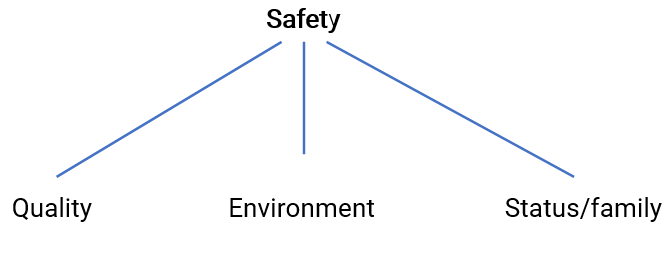
A “character” trait that was supported by Quality (1970s), Environment (late 1980s) and Status / Family was added in the 1990s.

A system that can be easily transferred to profile Leaders, such as Tesla’s founder Elon Musk.

And for individuals also includes a negative line. A quality that we continue to call “red”.
And for Elon Musk’s part may become a “Risk taker”.

To be able to profile yourself, appearing and acting as a leader, instead of stagnating in a position as a manager?
Then you build your “house on rock instead of sand. And gives you the ability to stand stable when the storms sweep in.
Follow the process until you have a character matrix to start from, change, modify, refine. And above all: correspond – by clarifying the behavior that you consider necessary to live up to your now clearer character.

Alternative;
21 infallible qualities/abilities for a Leader.
Prioritization/ranking/definitions/explanations.
1. Faith in the future/visionary. The platform helps us look further ahead. Long term. Puts strategy over tactical short-term. Sees opportunities before difficulties. Open to improvements. You are prone to change, and constantly learning. You realize Darwin’s first law: “An organism that does not evolve with – or faster than the environment, it dies! – also applies to people.
2. Competence. Knowledgeable / learning / developing. You not only have the knowledge, but you are also able to use it. You are aware of your qualities and have good self-confidence. You know your areas and have enough insights about the industry to be able to build and improve concepts and develop new businesses.
3. Responsible. You do not back down from your duties, obligations, or commitments. You never blame yourself or do not meander, problems are there to be solved. You protect your employees and take on their possible failures. Quality thinking is also part of your mental toolbox.
4. Committed / present. You stop, think and focus. You are “passionate” about the task. You welcome challenges, you “see” your employees, and you put the company’s best in front of yourself. You do not give up the long-term strategy for short-term tactical dispositions. You engage your employees early on in the projects.
5. Humor/distance. You are able to laugh at yourself, your faults, and your shortcomings. Humor provides a beneficial distance, which helps you see things as they are. You take the questions/projects/tasks bloody seriously, but not necessarily yourself. Humor is an underestimated trait, perhaps the most important tool available.
6. Powerful. Dynamic/energetic/brave/offensive. You take action without waiting for “administrative” directives. You have the courage to make decisions that you stand by even in “storms”. You do not roll your thumbs until the chance is gone. You have courage and are fearless in the face of conflict.
7. Responsive/empathetic. Listening. Learning. Developing. Team player. You get an impression of the surroundings and try to move with the times. You are inclusive, empathetic, understanding, approachable, and responsive to employees, their questions, and problems.
8. Holistic. You are “global” as well as local. You see the whole before the parts. The team before the self. You prioritize long-term solutions before short-term “extinguishing” fires. You would rather play chess than remain a piece in the hands of others.
9. Solution-oriented. You see solutions to problems, before problems with solutions. You have the ability to adapt in the style of Darwin’s second law: It is not the strongest, nor the smartest, but the one who adapts best, is the winner. You are fast, competent, and efficient. And constantly thinking about the whole, at the same time as the consequences.
10. Goal-focused/concentrated. Bets on one line/activity before several. Laser focus instead of the light bulb (which leaks energy like a strainer). You have the ability to prioritize what is important over what is urgent. You are determined, consistent, and fearless of conflict.
11. Creative. Flexible/open to ideas. Creativity does not necessarily mean innovation. The ability to combine different knowledge in new ways is enough. And if you also belong to those who can take ideas to the finish line, you belong to the 5% who run the companies.
12. Analytical. Methodical/systematic. May sound a little sad, but regardless, you do not have to go into defensive management. With well-founded theories, you can face adversity in the hallway, while ensuring success. Accuracy is also included in the mental toolbox.
13. Effective. You have good simultaneous ability and are able to accomplish a lot in a short time. Your ability to deliver is largely based on your talent for prioritization. You are productive, you do not waste energy unnecessarily: your efforts are significantly greater than the leakage; irritations and frustrations that you rarely leave to ferment.
14. Straight ahead. Reliable/honest. You are consistent. You say what to do, when to do it, take action and do it. You are safe, secure and honest. You understand that lies not only undermine your self-esteem, but they also impair your concentration around goal focus and prevent you from reaching all the way.
15. Fair/independent. A difficult balancing act because it involves your own, personal interests. You are a humanist who likes to see others develop. You put the team in front of the self. You like to stay in the background, and let others get the credit.
16. Loyal/solidary. You are one hundred percent loyal to the company and the employees. You sometimes even take on the “blame” even if you have not caused the problem. You protect and nurture the brand, while always standing up, and expanding your responsibilities, rather than trying to get rid of tasks.
17. Useful/Profitable. You put profitability first, the one that gives the company/division, the department freedom of action. You put income before expenses, and hard work before seeing difficult things, which is important to get rid of at all costs. Smart priorities are also in your mental toolbox.
18. Competitive. Competitive/driving. Properties that radiate energy, but which risk turning into “gaming”. The border in between is a thin line. Lack of patience is your biggest enemy, the driving force is your best friend.
19. Entrepreneur. Active. Full of energy. You are one step ahead. You constantly make sure to move forward, you are driving, you take action, you are constantly active, and leave to others both the hunt for titles and staff care.
20. Winner. You see opportunities in everything you do. A risk taker who goes close to the obstacles, the difficulties, as successful slalom skiers go close to the canes. You do not accept second place, and are therefore no stranger to rewriting rules, goals, budgets and gaining benefits in terms of resource allocation.
21. Smart. You are goal-focused and have the ability to time tactics with long-term strategies. Your competitive intelligence is combined with the ability to judge people’s characters, to be able to use them for the good of the purpose and the goal. One thing that may sound manipulative, but as long as the purpose is good, it is the prerequisite for putting together winning project groups.

And for the red line, here are 7 traits to choose from, or choose your own.
Red line/negative line
Select only one.
1. Impatient.
The most important “negative” trait, as it can easily be translated as drive, forward thinking and entrepreneurship.
(A double-edged sword, which it is important to balance)
2. Stubborn.
Explained with persistent, goal-focused,
3. Passive/administer.
Explained with thoughtful, safe, secure, and responsible.
4. Defensive/coward.
Explained with thoughtful, safe, secure, and responsible. Waits vs unnecessary risks.
5. Risktaker.
A necessary attribute for development. The options stagnation, the company’s slow death.
6. Cynical/cold.
Prefers rational solutions over emotional ones. Thinking of the company’s best. You do it better if you see clearly.
7. Egocentric.
Explained with goal-focused, goal-oriented, determined and self-confident.

Character in the workplace
Every person’s paradigm, perceptions, and skills are unique.
As stated by Deepak Chopra: “Awareness is all about restoring your freedom to choose what you want instead of what your past imposes on you”
Individuals should, as a result, perform activities that keep them pleased at work, as clarity around your character can reawaken and reconnect you with what matters to you.
Currently, most people work just for the purpose of earning money. In all actuality, that’s not what they truly are after, most people are after the feeling of what the money can do for them.
If one spends most of their waking hours at work, and if they aren’t clear about who they are and what they stand for, they won’t get the outcomes they want in the long run.
If we can integrate our own values with our work, we will be able to provide our all, in terms of work performance while also having a great time doing it. Because you are 100% true to yourself and your values, which lead your way forward.
However, as times change and individuals evolve, more people have begun to recognize the benefit of people with strong character.
The following are some of the top advantages of having clarity around your character:
• Encourage others to follow their own heart because character breeds character.
• Build resilience
• Buffer against, manage and overcome problems.
• Lead us to positive emotions, and meaningful life activities
• Improve the working environment.
“Weakness of attitude becomes weakness of character” Albert Einstein

Case study
According to Professor Andrew Wilson, at university of Illinois. Character education has become a nationwide movement that is increasingly receiving support among state governments, boards and professional organizations. Forty-eight of the fifty states have completed or are in the process of completing state educational standards which address character education. The growing popularity of character education and the resulting state mandates create many challenges for educators and leaders. We need to be able to answer questions like: What is character? will the people in the organization support this focus on character? what focus areas should we use? What’s the benefit of focusing on character? And how do we teach character effectively?
The conclusion is that leaders should teach good character traits explicitly, rather than leaving it to the “hidden curriculum”. Leaders are also typically called on to serve as positive role models and to seize opportunities to reflect on.

Exercise 1:2 – Character Matrix
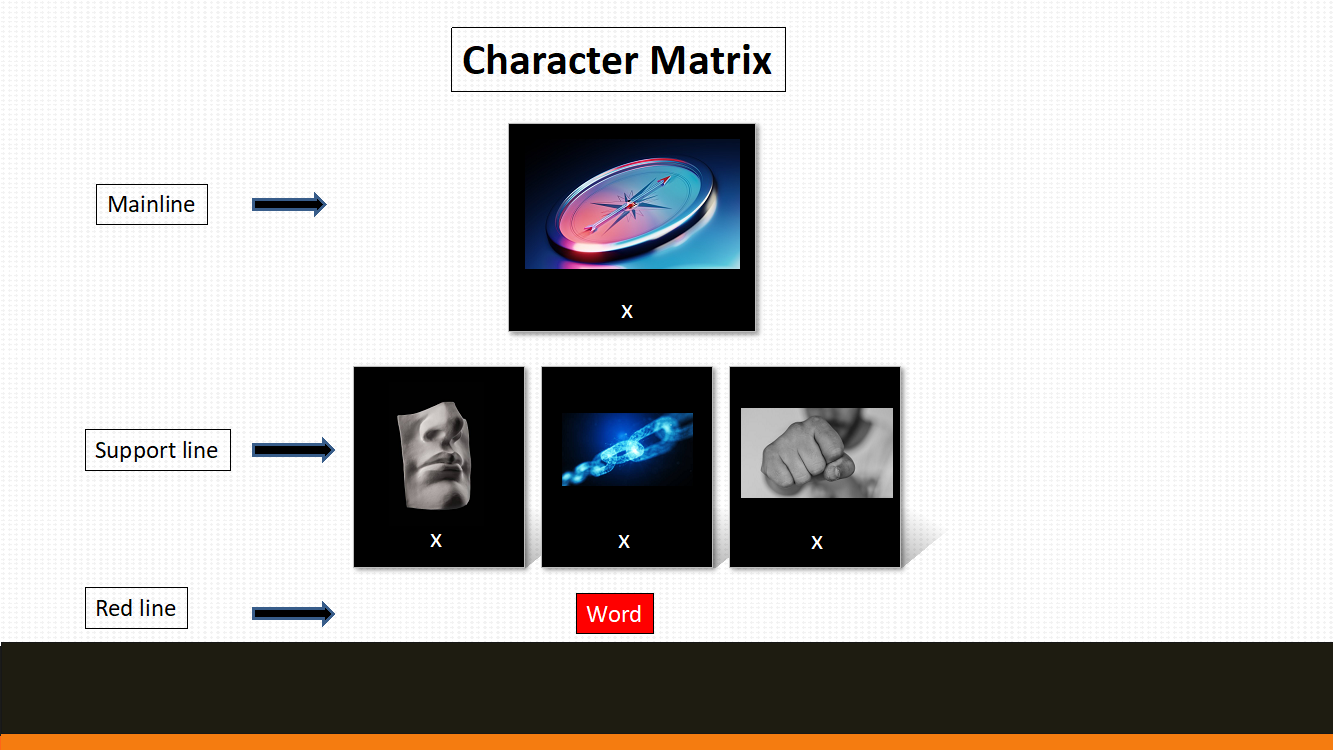
When you’ve built your first Character Matrix, make sure you put the words up where you can see them daily for the next 30 days. The benefit of that is that you will get more aware of your behavior according to your own strong value-based words.
The truth is, we are all unique, we have our own set of God-given talents, skills, education, and experiences. When we start getting clear on what our gifts are and what we’re standing for- this is when the magic happens- this is when we can discover our brilliance and make the biggest impact possible in the workplace.
When we align our careers around our character we will not only be passionate about what we do, but our co-workers, teammates, and customers will be attracted to us and your respected character.

Course Manual 3: Confidence Ladder
What’s the fastest way to build confidence and trust to create strong results? What’s probably the most important thing to do first? The confidence ladder is an easy tool to use, step by step to effectively build it up. These are all desirable qualities to possess. In this course, we will learn how to use the ladder in your leadership frame, and what the traps can turn out to be. Learn the 5 steps to confidently create the trust you so desperately need in your power as a professional leader.
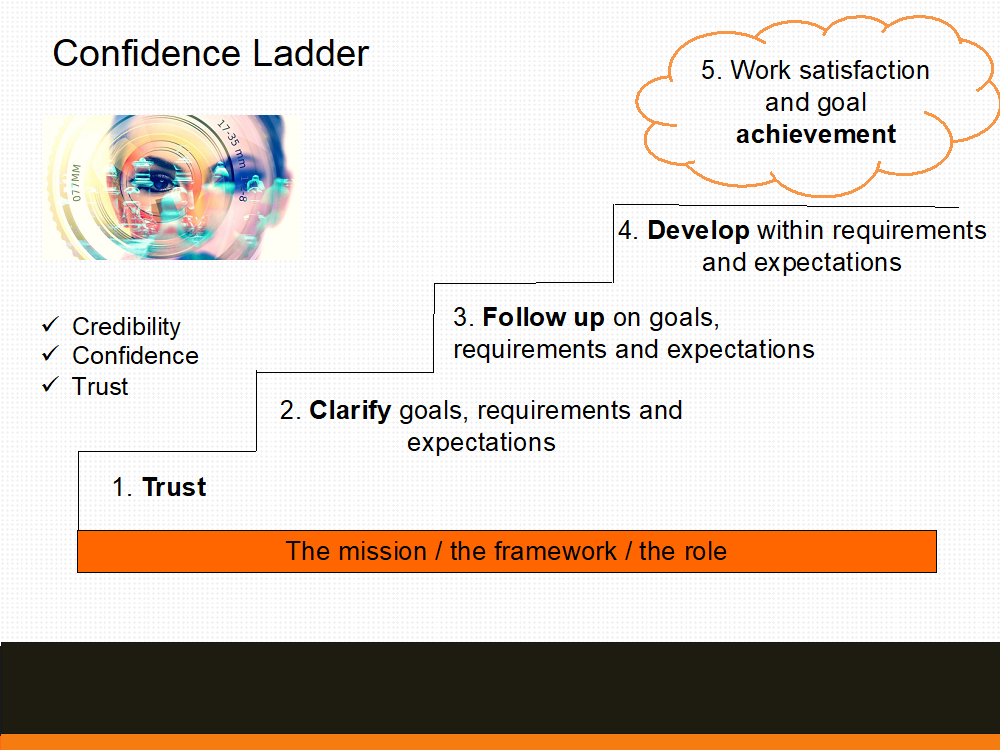
The Confidence Ladder Process
This is a process that was designed to assist in starting to unlock and get 100% conscious about the steps needed to be taken in order to as fast as possible achieve the last 5th step – work satisfaction and goal achievement.
Mission/framework/role
In the bottom base, we have the mission/framework/role. What kind of role is this, have we been 100% clear about this? do they know what you and your organization expect? Again, there is no care in being unclear, most people would like to be of service, as long as they know what you want them to mainly focus on in the role they’ve assigned.
1. Trust
The first step is all about establishing shared trust. That’s easy to say and talk about, but it’s not so common that leaders invest the time needed in this essential step. Probably because they haven’t seen the benefit of how fast you then can move on to the next step with even more determination. You may have heard the quote; “People don’t care how much you know until they know how much you care”. So how do you effectively build trust? Some of the best people to establish trust has been people working with interviews on TV and radio. They’ve used effective techniques for decades. They ask a lot of questions. Questions about what interests them, where they live, what they like, and sometimes about their family. Automatically they lower their “guard” since you show them respect and value their opinions. The benefit of that is that you now have the ability to have their full attention and more genuine interest in the next step, which is about clarification. So your investment in the first step can for some leaders be frustrated, because they want to achieve results fast, and don’t see the benefits of asking them a lot of questions. They jump right into the second step and tell and instruct from the start. This often cause that you will have to handle this area later on, and have lost your first important possibility to do It right away. The return of investment in time is huge, most of the time.
2. Clarify
In this step we as leaders need to reflect on the main thing. As stephen Coveys famous quote;
“The main thing is to keep the main thing the main thing”
We will come back to this in MIT (The most important task- later this workshop). It’s all about getting a laser focus on the main activity you want them to perform daily – what is that? When we ask leaders about this, they say they are very clear on this, but it’s not as clear for the people working for them. It’s more of a blur and can be likened to a light bulb that spreads its light in all directions, causing the rays to weaken. So make sure you think about one to a maximum of three activities you know is the core of activities that produce results.

3. Follow up
When, where, and how do you follow up on step number two? As a leader, the least thing you need is another meeting. So the way to do this most effectively is to use the meeting structure you already have. If you don’t have any right now, make sure to set it. The balance between too many meeting and too few are like a thin thread. We use to say that less is more, even in this area. Make sure you set a meeting structure you can follow and hold unto, even in stressful times. So make sure you go for as few meetings you can, but make sure you carry out those meetings every time with no exceptions. The benefit of that is that your people will know what to be prepared for on these meetings and the performance will increase in your team. Because most people would like and search for your praise. So if you’ve been 100% clear on step two, and always follow up on them regularly, you will have a higher impact on the results you’re after.
4. Develop
This is the area you’re suggested to plan for the year to come. Where, when and how do you plan to develop your team, and increase competence in your main area? In this developing step, very few leaders have a clear plan, with dates and themes for the training. Most people do a session aimlessly now and then. To be able to develop confidence and create a greater amount of achievement you as a leader are required to schedule timed and planned workshops during the year. Some use extended meeting times on already set dates. Some leaders weekly use 15 minutes of their meeting time to practice and focused training in specific areas. You can find your own way, but make sure you create a plan to hold on to through the year.
5. Achievement
Doing these four steps will not just build confidence and trust in your organization, but it will also faster lead you to step five: work satisfaction and goal achievement.

The three cornerstones of change.
We are where we are because of our habits. Let us state that. Whether good or bad, they control our lives. And it is only when you as a leader help your team acquire good habits – when you help them start thinking and doing things that you know are right- that they become satisfied with themselves and focus on their positive qualities and benefits, rather than their shortcomings. The previous boundaries are being pushed forward, and the picture of success is becoming increasingly clear. They begin to visualize things that have been in their dreams, but which now can become a reality if you help them just practice, the positive images. It’s like working out in the gym, the same things repeatedly. In this way, mental training and culture have great similarities with physical. You act depending on what image you have. Possible or impossible? It determines what – and how you visualize the change, based on three cornerstones.
Intention
It all starts with an intention. Whatever it is, increasing sales, getting rid of bad behavior, taking a few steps in increasing the customer experience measurements (CEM). And so on.
An intention strengthens their will to action, which is so powerful that they become independent of other people’s opinions. They finally just say to themselves: no matter how tough it gets, I’ll fix it!
Inspiration
Inspiration is the fuel that keeps the passion alive. In spiritus, “in the spirit”, an inner journey that set you on fire.
From Intention to inspiration to passion, when the flames of passion are strongest – it creates drive towards the third cornerstone;
Initiative
Trying to make a change without taking initiative, is like sitting in front of the fire and wishing for warmth, without having either matches or firewood. But when you have the Intention to do something, Inspiration enables you to do it and take Initiative, then you will most likely get what you want. That’s the good news.
The bad things are that the behavior you do not want – will automatically happen when you surround yourself with people who say that the project is impossible while taking your thoughts in an active direction.
You cannot increase your customer service score by just thinking that you hate being below average.
Take action on the target and visualize how you achieve it. You cannot get rich by thinking about how much you hate being poor. You cannot be successful by looking at yourself as a loser.
At the same time, you rarely get what you want – if you only focus on what has been.

Case study:
Trust is intriguing. Trust is valued-yet misplaced trust can be dangerous. Trust is needed when we lack knowledge, yet we have most trust in those we know best. Trust bestowed can be both an honour and a burden; distrust is rarely welcome. Trust is primarily a three-place relation, involving two people and a task: you may trust me to look after your children, to keep a secret, or to tell the truth. We do sometimes speak of simply trusting someone. Trust involves expectations about both competence and willingness: when you trust me to look after your children, you take it that I am capable of childcare. According to Katherine Hawley – University of St Andrews.

Exercise 1:3 – Step 2 & 3
In summary:
Possible or impossible – it is determined by your attitude, mental image, and the trust you build in your organization to increase their confidence.
It will be the way you think if you constantly visualize your successes – and take action on what you want more of. It is not the strongest, nor the smartest, but the one who best adapts to change is the winner. Charles Darwin stated that more than 150 years ago. Use the three pillars of Intention. Inspiration. Initiatives. And you can become a winner in the spirit of Darwin.
So take action by moving up the ladder step by step with a gameplan that are working out for you and your organization where you are right now.
Trust and building confidence are the rock-solid ground that gets you there.

Course Manual 4: Are-Can-DO (ACD)
The #1 feedback tool to take into consideration to create strong value-based leadership culture; Are-Can-Do. Where is your feedback from? In what circumstances? To create what? We have a way of using the first two of them too easily and unconsciously. Versus taking the behavior into consideration as number one. What we see as possible, determines our success. If we see an opportunity to change for the better by using the conscious mind when giving feedback, then we are laying a steadier foundation for change. Always try to expand their possibilities for new angels and perspective, since new perspectives create new opportunity.
The focus of this lesson is on using the right base to start from. To be able to transform mindset, we must transform our use of angels to feedback. We will learn 5 Easy Steps to increase your feedback. To be able to create a higher level of focus on the importance of value-based behavior.
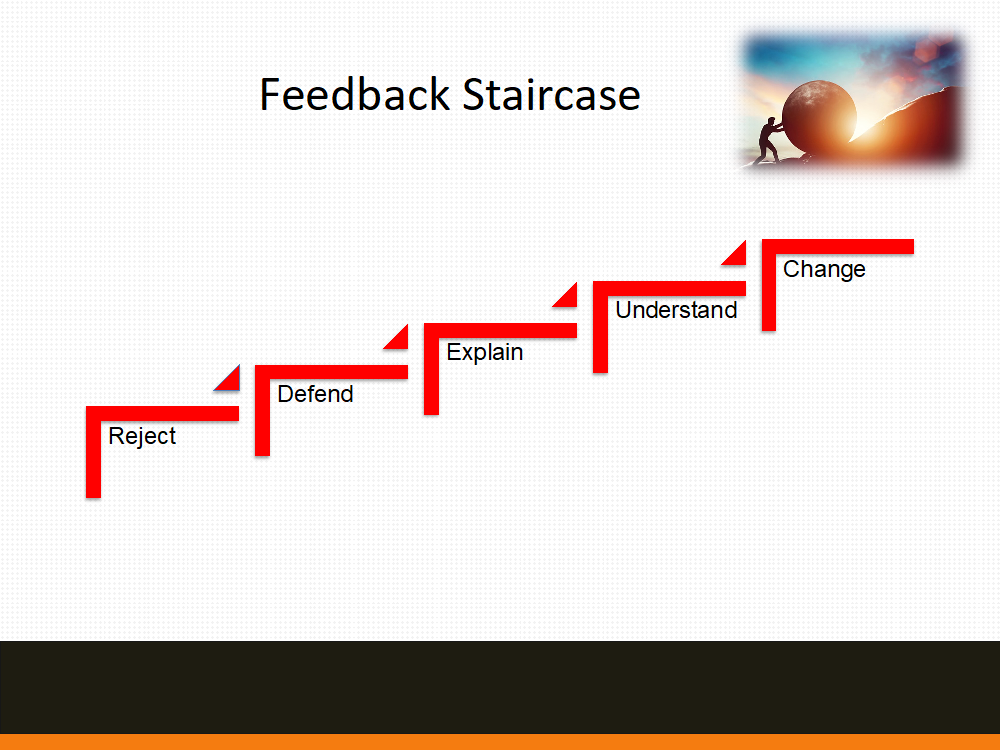
Feedback Staircase
Let’s start with the feedback staircase. It’s a common tool to acknowledge where on the staircase the receiver is. The benefit of knowing where they currently are in this area is that you as a leader then know how far they’ve come in their insights of the actual situation you discuss.
Rejection
The five steps start at the bottom with rejection. This is the step which is furthest away from a change of them all. They are in totally deny and don’t understand at all what you’re talking about. Example: They reject what the person says and can react with anger: “This doesn’t apply to me, you can find someone else to blame…”
Defend
When they start to defend their behavior the first thing they do, the only positive thing is that they are one step further up from rejection. Example: You blame others: “No, it wasn’t like that..” “It wasn’t my fault..”.
Explain
An explanation is very common in feedback as you probably heard many times yourself. Then you know they are halfway through to admitting change in the area. Example: Finds excuses: “Yes, but, it was like this…” “How should I know…”
Understand
They are almost there, they’re not angry or disrespectful, they are willing to change. Example: They receive, listen and think about what you said, become aware, and accept. Perhaps asks counter-questions if necessary.
Change
The highest step of the feedback staircase shows that they are willing to do the necessary changes you require or ask them to do. Example: They listen, absorb, and consciously make a change in their behavior.

Case study:
According to brain scientist Torkel Klingberg, speaks about different types of motivation; extrinsic motivation and inner motivation. Extrinsic motivation for example is when children do their homework and are rewarded with 1 hour gaming, and also when we as adult go to work and receive salary at the end of the month. Since Klingberg’s research pointed that money has little to do with it, he turned to inner motivation, which is the same thing as doing something because it just feel right. Klingberg speaks about an experiment where two groups had to do the same IQ task. One group were told that their results come from they were being smart. The other group were praised for their effort. When both groups were given more difficult tasks to solve, those who were praised for their decency worked harder, while the “smarter” ones found it easier to give up.
Feedback conversation prescription
1. Prepare the conversation – by asking yourself these questions:
a. Your desired outcome
b. Your main message
c. Likely objections to handle
2. Introduction
a. Be aware of where you choose to sit during the feedback
b. Prepare the other part to receive
c. Explain your own role and why you must deal with this
d. Show presence and active listening
3. Message
a. Be specific
b. Be short and clear on the subject
c. Ask questions of the consequences behaving this way
4. Problem-solving
a. Ask them first for a solution on the subject
b. Divide in to parts to easier get to a solution
c. Discuss the solution
5. Action plan
a. Summarize what you agreed on
b. Discuss What, when, who
c. Book a follow-up date
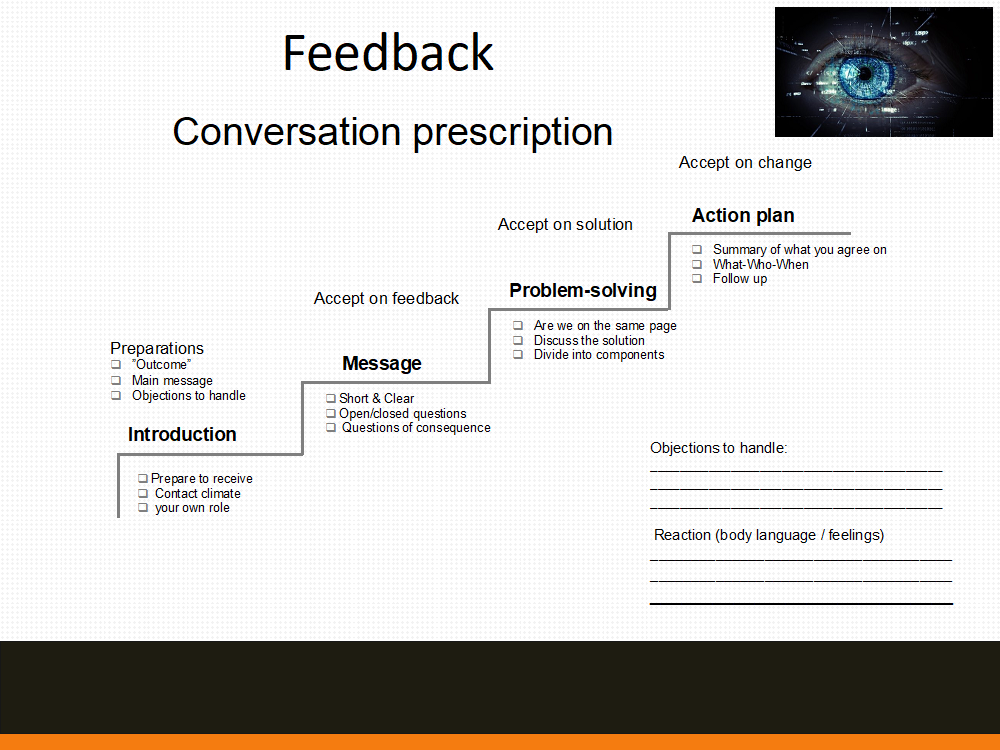
5 tips for effective feedback
• Don’t give feedback on the person (are) – give feedback on action (do)
• Give specific feedback – not general. Say “I” – Not we think or one thinks…..
• Only direct feedback towards something the person can do something about.
• Give just enough feedback-short and clear
• Ask how they perceived what you said

Exercise 1:4

Course Manual 5: Most Important Task (MIT)
Leaders that are self-confident appear to know what to do, when to do it and how to establish a culture of creating results fast. They invite people to trust them and fill them with confidence to be able to do the things they need to do, to get the result they need to get. But being aware of the most important task isn’t always simple, especially when the outside world affects us with all kinds of things both important and urgent. There are steps we can take to maintain focus on the most important task, which we will cover in this course.
There is a distinct difference between those who drive towards their goals and get the results they need and those who don’t manage to do it. It has nothing to do with time, that’s the only thing we have the same amount of.

Case Study:
One of Volvo’s dealerships in Sweden separated itself from the others by choosing a different activity as the MIT (Most important task) from the others. The chosen task: Booking meetings with prospects as the MIT. The others also had that on the list, but not as MIT (number one laser focus). During a period of 3 quarters (9 months) they measured the change in meetings and sold cars from the previous year, and with the other dealership in the same region. The focus on the specific activity turned out to result in small changes during a week, but with the weeks adding up – the consistency paid off during 9 months with 155 more meetings and a total of 32 more cars sold – as a direct impact from the activity. That may not sound much. But thirty-two cars with an average sales price of 562 000 SEK, equals an increase in turnover of 17.98.4000 SEK. With just deciding to focus on one specific activity as number one.
Mental strategies connecting to Most Important Task
Did old Charles Darwin keep track of the mental trials that the newly popular sport- biathlon exposes practitioners to? How much energy is needed to handle the shot when they have reached an extremely high heart rate on the ski track; what tactical moves should you have in your back pocket – depending on the weather, the competition, the shape, and the ability to be the best at crucial moments.
It’s like any project. You are in control until the problems start to appear; delays, worries about delivery, the competition that was tougher than you thought – and then you move on to the problem-solving phase, which prioritizes tactics before strategy or rush before importance.
And take you to the wrong path, in terms of goals.
How do you then, draw together the mental strategies that last all the way? “Tactics is about winning the battle, strategy about winning the war,” we usually say. An explanation that is useful from both the temporal perspective and the whole – rather than the parts.
Things that recur in the tips and my menu for terms of successful mental strategies.
Prioritize one line, over several.
What you invest in depends on your strengths and weaknesses, to try to develop and wind down. This reasoning is double-edged, because, at the same time as it is important not to get water over your head, it may be necessary to invest- in order to move forward. So figuring out your organization’s MIT (most important task) is of the greatest importance.
Prioritize the whole over the parts.
Let the whole lead, not the parts. Put the big in front of the small. The total is in front of the details. As Chinese General Tsun Tsu stated 3,500 years ago; strategy without tactics is a slow path to victory. Tactics without strategy are only noise before defeat.
Prioritize long-term over short-term winning.
Borders tend to move. Therefore, it is important not to be tempted to catch on to the trend without having thought through the consequences for the long-term plan.
Keeping goals focus long-term is far too important to succumb to the temptation to satisfy oneself in the short term. Take your development step by step- and it will work out.
Development of competence
“An organism that does not evolve with or faster than time, it dies,” stated Darwin, and mentioned something that is becoming more and more obvious. If you don’t keep up with developments, you risk elimination.
Always have the needs for competence development with you- always make sure that there is room, both in terms of time and resources, when you sketch your mental strategy.
Blessing In Disguise. Success disguised as adversity.
When things seem to go the wrong way, do not despair. Instead, consider the situation as an opportunity for something better. And you have adopted an approach that not only solves the problem, but it also prevents drops in blood pressure, both physical and mental.
To be able to turn adversity into success.
Can there be a better mental strategy?
Impatience –The double-edged sword.
Everything should go fast, which makes it difficult to keep track of the strategy, that it is maintained despite the eagerness to act. This applies not least to me- who has the slogan “It is always action that separates people” Life is not about ticking off the to-do list and doing high-fives, at the same time as certain measures of impatience drive development forward
Impatience is a double-edged sword – that needs to be balanced.
In summary
It is a matter of prioritizing:
• One line over several – your MIT
• The whole over the parts
• The long-term over the short-term
While preparing to develop beyond the current safety zones.
To play chess – instead of being a piece on the board that others move around
That’s what Mental Strategies and MIT are about.

Exercise 1:5
One of the key benefits of having your organization know your MIT is that you will encourage the behavior that produces the strongest results quickly. And since most people like to get positive affirmation, they tend to focus on your MIT to get the approval they strive for.

Course Manual 6: Facts & Feelings (F&F)
Where do you mainly make your decisions from? It can be difficult to see the difference between facts and feelings. It’s rather more normal to see feelings as facts instead of an opinion.
You probably already know this without even realizing it! However, to keep things fact-based, facts and feelings must be differentiated. A feeling is not a fact and should not be used as the only evidence to support one of your decisions. Determine if there is any other evidence available. While you gain clarity on which foot you stand when making decisions, you also gain higher self-confidence to hold the line all the way. In this lesson, we will discuss the traps and the benefits of using a more conscious platform to be able to secure your long-term decision-making.
7 Steps to help you make decisions easier
How difficult do you find it to make decisions? Do you sometimes put off decisions just because you can’t make up your mind? Then it might be a good decision to reflect on this…
You make lots of decisions every day, both at work and in your free time. Small decisions like what to eat for lunch, what to watch on TV, what clothes to wear… And bigger ones like whether to invest in project A or B, whether to dare to accept a job offer, whether to go on that holiday…
Often the decisions can be made quickly, but sometimes we all get stuck. And then the risk is obvious that the decision is postponed, time and time again, which is not only frustrating but also creates both unhappiness and stress.
Guy Winch, psychologist, author, and esteemed lecturer, shares in Psychology Today his advice for overcoming decision anxiety. Here are his seven steps to better decision-making:
1. Clearly formulate what the decision is about and what steps you must take. This may sound strange but imagine that you really want to go on holiday but unfortunately don’t have much money. The decision is then not about “Should I go on holiday?” or “Where should I go on vacation?” but rather “Will the best vacation I can afford to be worth the money?” So, first, find out what vacations you can afford, then decide if any of them are worth the cost. That way, you might avoid an empty bank account or a failed trip.
2. Remember that you have three paths to take – and that one must be avoided at all costs. Suppose you want to change jobs and after a while find several vacancies you are interested in. Now you have three options. Either you are looking for one or more of the jobs. Or you decide not to apply. But there is a third – that you do nothing at all. The latter two lead to the same result (no new job) but affect you very differently. Indecision can lead to both stress and anxiety and takes up a lot of your time unnecessarily.
3. Write down the advantages and disadvantages of your various possibilities. If your gut feeling can’t help you reach a decision, a plus and minus list can be a good aid – and it should be in writing, not just running around in your head. Try to include all possible perspectives and let it take some time so you can fill in as you go. When you’re done, look at your list – what does it tell you?
4. Set a deadline for your decision. Some decisions have a built-in deadline, e.g. to look for a job or if you are going to visit family and friends this Christmas. You are simply forced to make up your mind, otherwise, the chance is gone. But many decisions don’t have a “use by” date (clean your desk, go through unread emails, start exercising…) and here you can do wonders for your decision-making if you force yourself to set a deadline. E.g. “By Friday at the latest, I should have decided if I’m going to invite my workmates home”. When Friday comes, it’s either a “Yes” and you get started or a “No, not right now” and you set a new deadline much later or a “No, that’s not a good idea” and you stop thinking about the question. A decision to do nothing is also a decision!
5. Visualize more. We often make decisions based on gut feeling, or intuition, but it’s a good idea to give our gut a little more information to help us along the way-facts. Think about the different possibilities you have and try to picture for yourself what will happen when and if you make a certain decision. What would happen if you e.g. started that Spanish course? Does it feel fun, and inspiring? Would you benefit from Spanish in your work? On your next vacation? How much time would you have to spend? Is there something you don’t get time to do, something you would have to give up? Etc.
6. Add up everything you have from the above points. Hopefully, you now know which way your decision is leaning and it’s just a matter of going from thought to decision and action. If not – move on to the next point.
7. Sleep on the thing. After a good night’s sleep, most things usually become clear, and you have an easier time seeing the advantages and disadvantages of your upcoming decision. However, don’t let it be too many good nights’ sleep – see point 4 again.
Most of the time, it is the fear of making the wrong decision, of failing, that makes us hesitate. But then we can find some comfort and inspiration in the words of hockey legend Wayne Gretzky:
“The only shot you’re guaranteed to miss is the one you don’t dare to shoot”.

Case Study:
Feelings are not facts. What we feel is not a dictation of reality but a response to reality. By connecting with our emotions, we become more in control of our feelings, thereby becoming more in control of how we respond to the facts of life.
First, it is important to understand there is a difference between feelings and emotions.
Emotions are our evolutionary ability to respond to life. Fear, anger, sadness, happiness- our primary and secondary emotions are the way we interpret and make sense of life by celebrating it, questioning it, mourning it, and even fearing it. Emotions are physical experiences rather than strictly mental ones. For example, fear and anger are caused by the stimulation of the fight or flight response regulated by the amygdala and sympathetic nervous system. This stress responses releases hormones into the body, preparing it for physical action like running from a predator. All emotions are processed through the limbic system, which is separate from the neocortex. Our rational thinking, reasoning, and consciousness come from the neocortex. Since the limbic system is separate, emotions are not processed with the same decision making. As most people experience, emotions are often irrational.
Feelings are not physical. Instead, feelings are psychological or mental reactions to emotions. Emotions are shared by all human beings. All humans feel sad and happy, unless a severe psychiatric disorder prevents them from truly experiencing their emotions. Not all humans feel the same feelings. Take for example grief. People grieve in different ways because there are different feelings associated with the experience of grief. Some people are angry, some people are indifferent, some people are sorrowful. Our perceptions directly influence our feelings. Our experience, as human beings, directly dictates our emotions.
“Feelings are not facts” is a sentiment you hear often in treatment because it is true. Feelings are not facts. Feelings are a response to facts. As an example, it is fact that you stepped on a piece of glass. Your emotional reaction might be fear, anger, and sadness. Your feelings could be that of being scorned, resentful, punished, victimhood, and much more. Feelings are created by your perceptions, your experiences, your temperament and more.
Tree house recovery

Exercise 1:6
Facts & Feelings
In a summary, you will always have challenges with these two words. Since they mix up in your mind, your mind tends to “keep on talking” and create feelings, which you then tend to take to many decisions from. To be able to be sober in your decision-making, we generally recommend that you lean more on facts in major parts of your decisions. What is true here? What has happened that forced us to decide?
Lean on facts in more part of your decisions, and they will help you hold the line in the long run. Another and maybe the strongest benefit is; It is hard to argue against the truth!

Course Manual 7: Four S’s (4*S)
One of the leaders’ main things to reflect on and be more conscious about, is the kind of relationship they want to have with themselves. Your interaction with others improves when you have a healthy relationship with yourself. That is why the parable with the security announcement on flights are so excellent example of this: “good morning, ladies and gentlemen and welcome to this flight bound for Stockholm….in case of an emergency, oxygens mask will appear, first put on your own mask, before helping anyone else” (otherwise you are no use to nobody). My personal experience in this area is that to be able to connect and build trust, you must first be able to connect and be emotionally available to yourself.
So, what does a healthy self-relationship look like?
A healthy self-relationship is the ability to value oneself as a person and accept and embrace our weaknesses.
One of the best returns of investments you can do in life is investing in yourself. To be aware of your status in four main areas:
• Self-knowledge
• Self-esteem
• Self-trust
• Self-confidence
It doesn’t matter if it’s about building your leadership skills, working on your relationships or personal development; we must get to know ourselves first so we can meet the necessary requirements from others on a larger scale.
Why are the benefits of knowing where you stand in these areas so powerful?
Some of the major benefits of establishing clarity in the four S’s is so obvious; It shows that people with a high level in these four areas generally have more success at work, stronger relationships, and a significant higher mental and physical health.
It sends a powerful signal to yourself. The signal is I’m worthy, I’m strong and I’m valuable. In this lesson, you will discover where you stand on those four areas and create your own clarity on how to strengthen them step by step

The first thing we will address is: How to increase your Net-worth by increasing your Self-worth. Jim Rohn stated so wisely; “Your net-worth will likely never outperform your self-worth.”
There is two questions we as leaders need to answer to be able to lead at a higher level long-term. The first question is -what do I do right now to improve myself? The second is – what do I do right now to improve others? This is all about question number one.
Which really means; work harder on yourself than on your work. Then, and only then will your ability to increase your net-worth strongly improves.
Let’s look in the basic of the benefit of this marvelous insight. The distinction between these following four words appears to often be misunderstood.
Let’s look at the differences between:
• Self-knowledge
• Self-esteem
• Self-trust
• Self-confidence

Self-Knowledge
What exactly is self-knowledge? What do you automatically think of when you hear the word self-knowledge? Most people, I believe, consider the four words to be difficult to separate. They are not interchangeable.
Why is self-knowledge important?
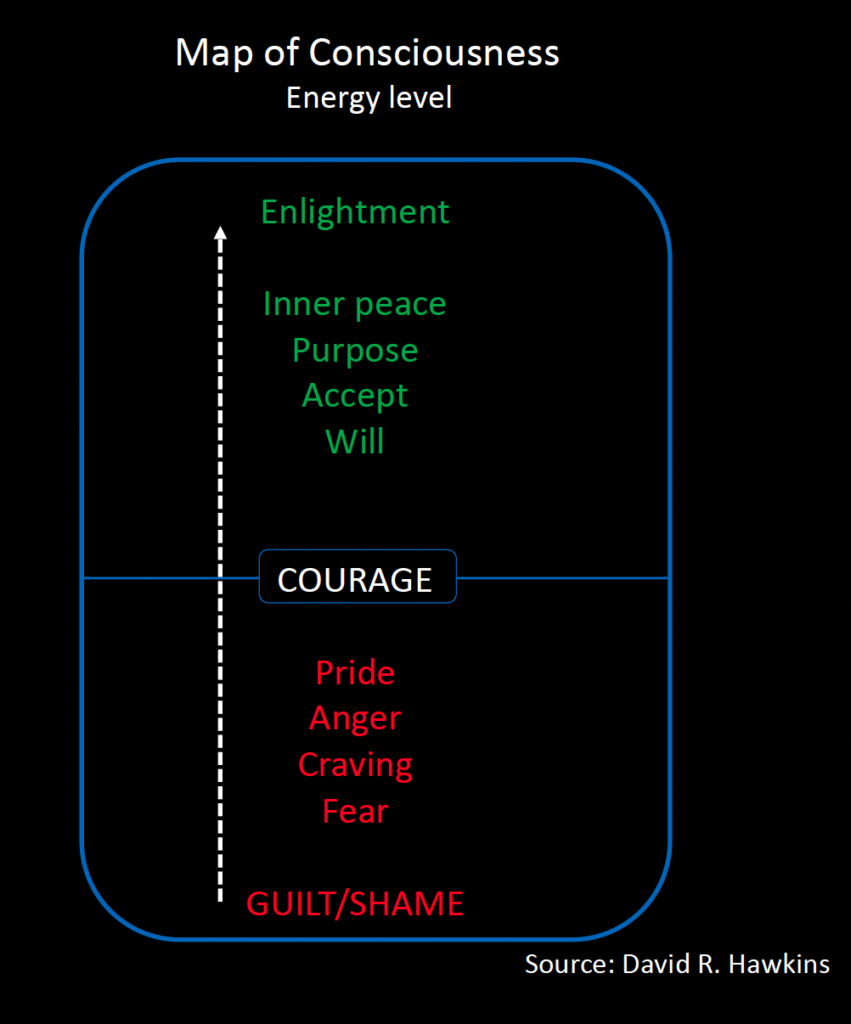
Self-knowledge is essential for being conscious about your strengths and your weaknesses. Most people are not. In philosophy, “self-knowledge” refers to knowledge of one’s own mental states—that is, of what one is feeling or thinking, or what one believes or desires. Which means that you know where you stand in terms of value in different areas. That’s why we have started in the beginning with your Character Matrix. To make people reflect on their values, which helps them to take decisions in all areas further on. An originality which comprises their character. It is a way an individual knows and comprehends his own personality, thought processes, and values.

Self-Esteem
Strong Results with higher self-esteem.
Self-esteem of course means having a good feeling for oneself. At the same time, it is about building one’s personality around well-chosen qualities. And take control of their lives.
And if you want to reason your way to what increases – or decreases self-esteem, you can consider it a kind of personal currency. With assets increasing in debit, and liabilities increasing in credit.
Assets / debit
Body language is perhaps the clearest sign of self-esteem. The eye contact, the smile that comes from within, and the unadulterated smile that shines with optimism.
The greatest asset, however, is the character that is characterized by perseverance, the ability to take action, resist disappointment and adversity.
To listen to your own dreams rather than the critical opinions of others.
To be able to laugh at oneself.
Coming to the realization that every time you make your fellow human beings feel better, your assets in the account increase, which pays off in a self-esteem that can set mountains.
Debit / credit.
Every time you blame your failures on others, every time you lie to get out of difficult situations, every time you deviate from your plan – your debt increases.
For every negative word you utter, self-esteem decreases. Banish destructive thoughts.
Every time you feel contempt for people you currently feel are “less” than yourself, self-esteem may increase in the short term, but decrease in the longer term. In the same way, revenge works. Short-term sweet, long-term sour.
Summary
Every time you say no to a temptation, a cake for coffee, a relaxing beer after the round of golf or acting against your instincts to dodge difficult things. And put your sourdoughs in the oven, instead of letting them lie and ferment.
Your self-esteem increases, right?
And makes you feel in control and a player of chess instead of being a piece in the hands of others to move around.
Try to keep a book for a week, over debit and credit, things that increase and decrease your self-esteem, your charisma, your belief in success. And you will find self-esteem in constant improvement.

Self-Trust
When you are now your strengths and weaknesses and can embrace them all, without losing energy. Then you trust yourself and can do the things you need to do with higher impact. To trust your abilities and remind yourself of what you can do by yourself, and in what areas you need help, is essential for making progress in the leadership frame. To be able to build your self-trust, you must first go through the character matrix, the self-knowledge, and self-esteem assessment. By this you remind yourself where you stand and can rely on your strengths on a much greater level.

Self-Confidence
People who have self-confidence appear to be at ease with themselves. They become like magnets which attract others to trust them. These are all desirable qualities to possess. But it’s not easy. Experience tells us that many are naturally self-critical. And for that reason, let others run the show for them, even when they don’t agree at all. What is self-confidence? It is a quality that may be of great beneficial. It supports us in interacting with our coworkers, keeping us motivated through tough moments, and create stronger results during the workday. A strong self-confidence helps you to do the things you need to do, whether you feel great about yourself or not. A major advantage in every office is the ability to communicate clearly and effectively. A big advantage in the workplace is the ability to communicate effectively. Self-confidence permits you to accomplish this quickly and efficiently, allowing you to communicate effectively with coworkers and clients.

Why is it that most people searching for the approval from others before they can approve themselves?
What’s the most important opinion you have? The answer is always the opinion of yourself. And the most important conversations you have on any day, is always the conversation you have with yourself. These two builds your self-confidence over time.
But most people are more interested in listening to other people’s opinion and searching for likes, than what they selves value or think of the cause or happening. The reason is weak self-self-confidence. And if you are a leader, it’s one the most important things to work on and strengthen, to be able to get the strong results you are after.

Case Study:
Self-confident people know what they value and what they want. They share common habits and thought patterns that help them achieve their goals. One of the fundamental beliefs underlying confidence is, “My worth as a person is equal to everyone else’s.” That doesn’t mean you don’t have to work for what you want, and it certainly doesn’t mean that life divides up its rewards evenly. But it does mean you have the same right as anyone else to stand up for yourself, pursue your dreams, enjoy your life, and make a difference in the way that’s most meaningful to you.
A confident person can accept helpful feedback and act on it without getting defensive. When your sense of self-worth is no longer on the table, you can handle criticism or even outright rejection without allowing it to break you. By the same token, confidence doesn’t mean you mow other people down when a conflict arises. It’s possible to speak your mind with conviction and still make room to listen to someone else’s point of view and even reach a compromise. Perfectionism is a form of faulty thinking that contributes to low self-confidence. If you believe you have to have something all figured out before you take action, those thoughts can keep you from doing the things you value.
They don’t focus on themselves. It might seem counterintuitive, but when you have more self-confidence, you’re less focused on yourself. We’ve all been guilty of walking into a room and thinking, “They’re all looking at me. They all think I look dumpy and that every word I say is incredibly stupid!” The truth is, people are wrapped up in their own thoughts and worries. When you get out of your own head, you’ll be able to genuinely engage with others.
Barbara Markway, Ph.D., is a psychologist.

Exercise 1:7
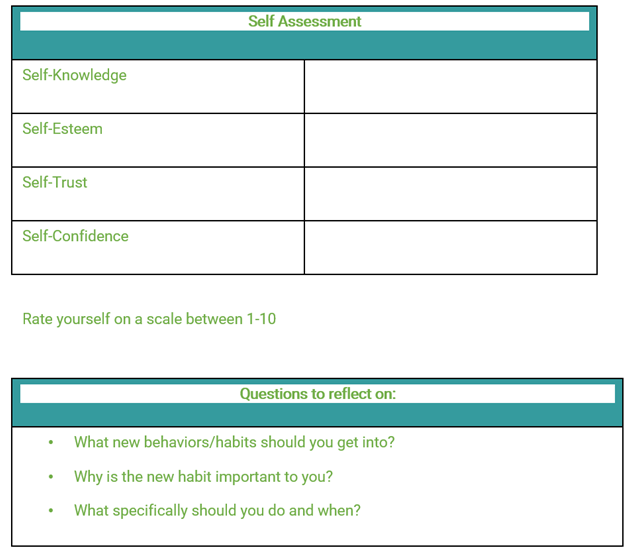
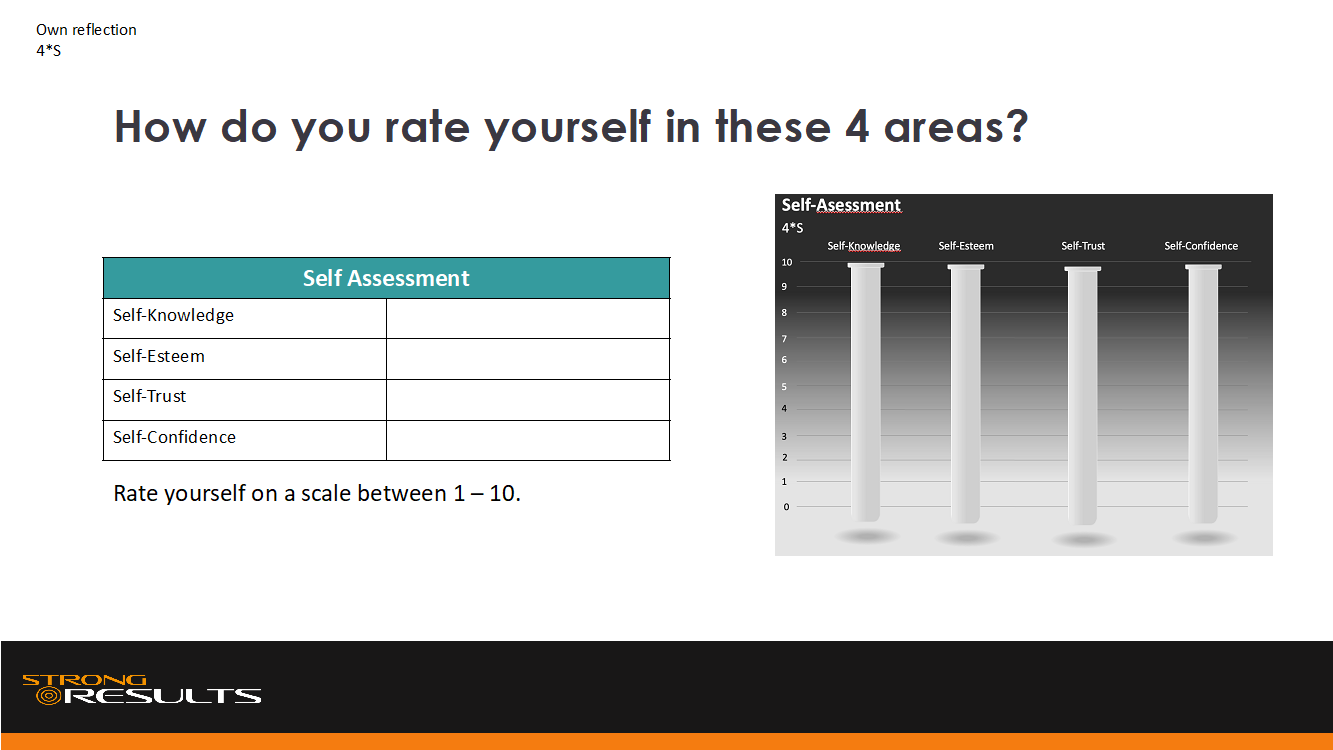

In summary:
To be clear, self-worth and net-worth are not determined by the amount of money you have. But the important perception of yourself, influences the amount of money or success we can accomplish.
Everything we do is influenced by:
• Self-knowledge
• Self-esteem
• Self-trust
• Self-confidence
Decide to go big. You are not serving with your great gifts by playing small. Don’t shrink to fit in because you’re scared of failing.
You can’t change anything until you’re prepared to get to know yourself first. It’s time for self-reflection and give yourself a greater chance to pursue your goals. You can do it!

Course Manual 8: “Same color of the shirts” (SCOTS)
What does it really mean; to build a strong, well-established foundation from the saying – “same color on the shirts”. It’s a well demonstrated perspective to have in mind, while you build your team and sound leadership frame. Which are recommended – to be built on core values. “SCOTS” so to say is a technique that require frequent reminding on how the “game” should be played in your organization. Who do what and when?
It has nothing to do with titles – it’s all about creating a habit of behavior, which are built on rock solid ground that is your organizations core values. It permeates from the top and vice versa.
Let’s look into a typical situation which often occurs in many large organizations these days. Let’s take IT department as an example:
Given that IT departments is taking on a bigger and bigger role in many organizations, due to digitalization, a gap often occurs between the business side and IT, due to lack of “SCOTS” mentality. Here are 5 typical situations on both ends:
• The business side often wants to lock in the cost, even before they really understand what they want.
• The business side often feels that if IT is falling short of meeting all of their initial expectations -then it’s a failure.
• The business side is often unclear about their real needs and tends to demand a lot of things they don’t really need.
• When they change their mind about what they want or need, they rarely adjust their original cost estimates and plans.
• The business side is often reluctant to spend time to better understand their needs because it will “take too much time”. Likewise, a failure will be blamed on IT.
The IT department are not innocent either:
• Even when they know they cannot provide cost and schedule estimates based on only a vague understanding of the needs, they provide one anyway. The project is then held accountable to this “vague estimate”.
• They often measure the wrong things, such as the production of artifacts, rather than metrics such as quality, risk reduction, and actual value measured in working programs.
• They are too focused on technology and not on creating business value.
• The technology itself is immature and not well understood and decisions are often driven by a desire to “play with the latest technology”.
• Team members often do not respect each other’s contributions. Developers look down on testers and business analysts. And vice versa.
In this specific example: Is there really no way to break down these barriers to teamwork and “SCOTS” mentality?
Well, the first step is to stop thinking of the business side as the customer and IT as the supplier. Instead, they form a team that reports directly to management.

Case study:
From a case study in Harvard Business review with the title
The New Science of building great teams
They could see in the data when team members will report that they’ve had a “productive” or “creative” day.
The data also reveal, at a higher level, that successful teams share several defining characteristics:
1. Everyone on the team talks and listens in roughly equal measure, keeping contributions short and sweet.
2. Members face one another, and their conversations and gestures are energetic.
3. Members connect directly with one another—not just with the team leader.
4. Members carry on back-channel or side conversations within the team.
5. Members periodically break, go exploring outside the team, and bring information back.
The data also establish another surprising fact: Individual reasoning and talent contribute far less to team success than one might expect. The best way to build a great team is not to select individuals for their smarts or accomplishments but to learn how they communicate and to shape and guide the team so that it follows successful communication patterns.

Exercise 1:8
•
Regarding the case study above, it’s essential that leaders focus and give credit on the traits and behavior that is consistent with the core values. This is not a quick fix of course. But step by step over time, there will be a huge difference and strength in the team with focus on the mentality of having “the same color of the shirts”. Which will lead to stronger results over time. An investment well worth it’s price in effort.

Course Manual 9: Attitude Indicator
Attitude is a term used in aviation to indicate the angle of the nose, which determines whether the plane will take off or land. Which is read by using an instrument called AI (Attitude Indicator). And which points upwards when the plane takes off, while the drag force is stronger than the air resistance and the lift force is greater than the weight.
Attitude is a concept that also applies to us humans, at the same time something you can control and is even more vital as a leader. We are judged based on attitude, conduct, and habitual behavior. Things that we collect under the concept of attitude. A kind of radar that sends signals to the surroundings. Whether it limits or balances us.
Being able to live life to the fullest is all about balance. About setting aside time to calibrate yourself to your morning coffee, 5 minutes a day that will change your life. People will want to work with you because of who you are, your great attitude and what you bring to the table. How do you reveal your unique proven powerful perspective that set focus on your mindset, and creates a thruster on your attitude forward?
7 Keys to a positive Attitude.
“I’ve never tried that before, so I can do it for sure!”
Astrid Lindgren’s Pippi Longstocking saw everything that came her way as opportunities. The word “impossible” was not in her vocabulary.
The adults failed to control her, the police officers Kling and Klang begged to get her into an orphanage and Dunder-Karlsson and Blom gave up when they were trying to steal her bag with gold money.
Pippi’s dynamic mindset and attitude shattered the old static views, the ones that so often chain our belief in success to rusty old ideas. A lock that kills your creativity, your forward thinking, your will and ability to take action.
Let me therefore provide you with the keys to a positive, dynamic and energy-generating attitude, which steers you towards success and calibrates you for strong results, while at the same time preparing you for the efforts required to reach all the way forward.
Key number 1: Know yourself!
Or gnothi aefthon as it stood on the walls of the ancient Greek schools of philosophy
Getting to know yourself, your strengths and weaknesses was – and is – a key factor for success. To find out who you are and how you react in different situations, while finding your own “sound”; your Mindset that is linked to your goals and identity. Much like ABBA did when, after many years of hard work, they finally found their special sound.
What is your dominant trait, which you can trust in any weather? Is it, for example, “efficiency”, “sense of responsibility”, “speed” or perhaps “Strategic”? To be able to develop further, it is important to find out what you are good at – and less good at.
Do not expect anyone else to support your personal development, start investing in yourself and choose an area to peak – and strengthen your skills in.
Which wave is most suitable for surfing?
At the same time, our different roles provide different conditions.
As a manager and leader, you should, for example, put the will to learn and develop – before talent. And give positive feedback on what benefits forward thinking and the ability to take action.
Regardless of results.
As a parent, you should praise efforts that develop their willingness to never give up and constantly acquire knowledge; primarily focus on their activities and secondarily on results.
Get to know yourself, so you also get to know others. Like you are playing chess, rather than being a piece, for others to move around.
Key number 2: Be open to everything!
Then your chances of a positive attitude increase. Dare to challenge programmed, static truths. Trying to sit on the other side of the table and think the other way around. The law of polarity; there is nothing left if there is no right, nothing up if there is nothing down. No inside if there is no outside.
Try to see opportunities before difficulties. Do not judge ideas casually; “We have already tried that “, “we have never done it” “it is outside our business concept” “it requires too much”, “we do not have time for it”, “we can’t afford it” and so on .
And that usually ends with “it never works”.
Do not close doors until you have carefully analyzed them; become dynamic and evolutionary rather than static and anti-progressive.
Key number 3. Load with faith in success!
Faith in the future, is that something you can train yourself to get?
First, you should make clear what success is for you. Is it money or fame? Is it to fulfill one’s mission/purpose, whatever happens and regardless of the result? Or success is about creating reality of your goals, and that starts with your thoughts, which lead to action.
The great feeling that makes you take ACTION.
Also think about what in addition to success – that motivates you. Research on mindfulness at UCLA shows that a grateful attitude changes the molecular structure of the brain, makes us healthier, happier and more proactive than reactive.
Can you start the day by thinking about what you have to be grateful for, I promise you a positive mindset, which you are happy to reinforce with things that make you proud; for example, when you advanced at work, came back after an adversity, were involved in the development of a business. When you met your spouse, when the children were born, when they started school, graduated or got their first jobs.
Play the “movies” on your screen, when you need a kick.
Faith in success, is it a feeling you can train to get?
The answer is unconditional – YES!

Key number 4: Control your mind – and let your mind control you.
According to psychology professor Carol Dweck, you have more influence over your brain than you think, because it works like any muscle, which gets stronger the more you practice. When you become fully aware of the possibility, you can change your attitude, mentality and attitude to life.
If you choose to look for gray hair when you look in the mirror, you will find them. Are you looking for reasons to procrastinate difficult things as well, just like reasons not to take action.
Alternatively, you can meet challenges with a smile on your face, treat your fellow human beings with care – and express a positive outlook on life.
You choose how you shape your thoughts, connect a positive Mindset and an emotionally beautiful picture of the future, and strong results will come to you over time.
Control your mind, and let it control you.
Then it will be as you think.
Key number 5: Do not waste energy on things that doesn’t take you forward.
First, try to surround yourself with people who give you energy. Positive key people who help you on the way to a Mindset that strives forward. Caring and honest people, who make you grow.
Evaluate your surroundings and be careful about who you let in.
Second, try to minimize energy-intensive irritations. Do not get upset over injustices, “idiots” who disturb you in traffic, on TV or Facebook.
Third, keep in mind that you have a responsibility as an employee, leader, and parent to create hope, commitment, and enthusiasm in your co-workers and loved ones.
A commitment that, together with your own development, does not allow wrong prioritization or unnecessary energy losses.
At the same time, the realization that life is not about ticking off a to-do list, but living in the present with a focus on the future.
Key number 6: Put dynamic approaches before static ones.
Generate energy before stagnation. Activity over passivity. And hard work in front of talent.
Research shows that children who are praised for good grades or are told that they are smart have a tendency to get stuck around a fixed way of thinking. While those who are praised for good efforts or high levels of activity, tend to develop dynamic mindsets that make the wheels spin faster.
Mindset remind me of my childhood when a dynamo was connected to the bike, to generate the energy needed for the lamp to light the way forward.
And just like you need to pedal to move the wheels for the lights to shine. And the stronger the resistance, the heavier the loads you lift, the stronger you become.
Just like dynamic Mindset produces people with fighting spirit. At the same time, static thinking avoids challenges and resistance.
Put dynamic approaches before static ones. Fade down the focus on results (even if it’s important) and highlight focus on activities. And create stronger results in the long run.
Key 7: See failures as opportunities.
As J. K. Rowling did when the book about the wizard Harry Potter was rejected twelve times before the first book was published. Adversity she summed up with: “Nothing is impossible if you see failures as benefits, work on your weaknesses – and focus on your strengths.”
She saw the rejections as driving forces. And turned frustration into success.
Some people seem to have it in them, the mindset that is usually called “Blessing In Disguise”. Success disguised as adversity. To turn trouble into triumph.
“What are the benefits of failure?” Is the question that your positive Mindset asks.
“There is no bad that does not bring anything good”, as the old saying goes. When doors close, new ones often open.
Life is a result of how we choose to think.
If you have the right attitude, you can apply the liberating mindset regardless of the situation; bring a higher level of positive thinking, which in turn increases the reward. And the more often you practice it, the stronger results you will get.
Seeing failure as an opportunity, can there be a better mindset and attitude?
To unlock doors to success: with the following keys;
Key number 1: Know yourself!
Key number 2: Be open to everything!
Key number 3: Charge yourself with faith in success!
Key number 4: Control your mind – and let your mind control you.
Key number 5: Do not waste energy on things that don’t take you forward.
Key number 6: Put dynamic approaches before static ones.
Key number 7: See failures as opportunities.
If you only follow half of the tips, I can guarantee that you will open the locks that have so far prevented you from reaching all the way.

Case Study:
According to Tchiki Davis, MA, PhD
What is a positive attitude?
Technically, an attitude is something that others observe in you. So whether or not you have a positive attitude depends on how you interact with the world, and how they see you. But what they see in you is often a reflection of who you are. Are you able to see the bright side of challenging situations? Are you kind to people even when they may not deserve it? Do you smile and laugh and generally enjoy life? Well, my friend, then you likely have a positive attitude.
Many of us might prefer to just be a Grumpy Gus — What’s the point in getting all jazzed up about everything all the time, right? Sometimes it feels easier to just be negative. But ask yourself this: Do you like being around people who are negative and complaining all the time?
This is why building a positive attitude is so important. We’re not only happier with our lives, but people are also more likely to want to be around us, which makes even happier yet. And other often want to help us and make our lives easier. It’s an upward spiral of positivity. People who struggle to have a positive attitude are generally good at finding the downside of any situation, person, or thing. They generate negative emotions easily and complain about all the problems they have, which can be many.
People with a positive attitude do the opposite—they always strive to find the upside. Really, these two perspectives are just two sides of the same coin. It’s all about positive attention. Do you pay attention to the good things or the bad things? If you want to shift your perspective, try to apply your canny ability to find the bad to develop your ability to find the good.
To start, anytime you are down about anything find at least one benefit
References
-Fredrickson, Barbara L. 2000. “Cultivating positive emotions to optimize health and well-being.” Prevention & Treatment; Prevention & Treatment 3 (1):1a.
-Siegle, Greg J., Frank Ghinassi, and Michael E. Thase. 2007. “Neurobehavioral therapies in the 21st century

Exercise 1:9

Or on this attached link: starkaresultat.se
Attitude in summary:
Considering that Leonardo da Vinci’s airplane was drawn 400 years before the Wright brothers’ first flight, one might ask what drove him to invent things so far ahead of his time. Curiosity and interest are two of the answers, but the question is whether his attitude was not the most important, the belief that he regardless of difficulty – fixed everything he set out to do. An attitude which probably strengthen your opportunity in general life.

Course Manual 10: Setting Large Frames (SLF)
Setting boundaries is essential to maintain a stable value-based leadership frame. Frameworks for responsibility and authority to make decisions. Have you established clarity for your organization in that area? Have you thought about the benefits that follow by doing it?
In this lesson, we will identify the benefits of a clear and safe framework. So we effectively can manage our time to create strong results faster. This frame should align with your core values. Firm boundaries that spread and benefits creativity in your organization.
Insight for a personal ownership attitude
The leaders’ role is to develop self-generated insight rather than to offer all of the solutions. This method demands forethought. A clear framework for responsibility and authority in the organization. Five strategies to help employees gain confidence and take ownership of their role.
Strategies for stronger initiative
1. As William Ernest Henley quoted: “I am the master of my fate and the captain of my soul” -There is no roadmap for progressing to the next level. The path to owning one’s role, as well as the challenges that arise, are challenging. It’s impossible to put yourself in someone else’s shoes. Let themselves make the decisions inside the large frame you’ve set.
2. The job description is only a guideline. – Employees are qualified wether they check out the boxes on the job description or not. Create an environment that encourages people to step outside of their comfort zones.
3. What do you expect? How clear have you been on their frame for authority and responsibility? Doublecheck that by asking questions to your closest team, what they have perceived in that area. When you foster accountability, more people tend to take ownership and the same time build their confidence.
4. Consider failure is just one step closer to success. You as a leader has been shaped by the mistakes you’ve made earlier in your career. Help your team and people to understand and grow the courage to do the things that need to be done. When you stop setting limits on decision-making and problem-solving, it tends to develop a culture of safe failure.
5. Positive Feedback – Leaders should provide specific positive feedback so that employees keep doing the thing that creates stronger results. That helps them build confidence in their skills. People that are given positive feedback, become doers and take ownership of their responsibilities and authority.
They will build higher creativity if they focus on developing their perspective. It’s up to them to do the rest.
Employees will be more likely to take responsibility under their clear set authority if you create accountability.

Building your clear large frame
Larger boundaries are established when we encourage a strong sense of self-worth.
Set some basis rules first, in alignment with the authority you give them under their own responsibility. With great power comes great responsibility. Be certain that everyone knows what your expectations are. When problems occur, it will be a lot simpler to put the burden of evidence on them, regarding the authority and expectations you’ve given them.
Priorities
Think about what’s most important for your organization. The priorities around the key performances are often the things that come up. Finding a balance between responsibility and authority is the key factor. It’s difficult to focus on what’s essential sometimes, which are your priorities, with continual demands from everyone around us. As we go through our days, our priorities become muddled. Deadlines, demands, and musts never seem to end, and before we realize it, we’ve pushed the most critical tasks to the bottom of our to-do lists.
So the first task is to figure out your priorities in the organization.
Remember that your priority should be the things you know create the strong results you need. The activities that will help you achieve your objectives. Always stick to your priorities – no matter what!

Abstract leadership
Lead like water.
The art of staying afloat.
“That which is soft, adaptable and enduring – overcomes over time, any obstacle” -and gives strong results
For the whole to work, the parts must also be in place. One thing that becomes very clear when 60% of the body consists of water. If the balance is not in place, the energy is drained. A vulnerable situation requires you to keep an eye on your flow.
Here are three tips for a more fluid approach to leadership.
Don’t grip too hard.
Then it disappears. This applies to many areas of life, water just as with love. From a leadership point of view, it is common sense, unfortunately, common sense is not so common anymore. If, on the other hand, you open and receive with open cupped hands, you will receive it in larger quantities.
Let it flow.
Just like water that stands still or is closed in for too long – stagnates and becomes sick over time. In the same way with our fellow human beings. If we set “frames” that are too narrow, creativity and flow stop. Feel free to put frames to help the flow in the right direction, but let the frame be as large as you can – depending on the situation. Just as energy generation in hydroelectric plants requires a strong flow, we need to allow the flow to have room to create strong results over time.
Don’t place yourself above others
Water never naturally seeks higher heights. It flows with the current and seeks lower terrain, where it collects in energetic rivers and deep seas.
If we allow ourselves to flow with the current and gather us where we naturally belong. Then we build a greater depth over time. Just as the one who talks the least and asks the most also in the end knows the most – in the same way with water, which gather and builds depth. Be careful to place yourself above others. Go to the “lower places” and keep an open mind. Give them the respect they deserve – we are all equal.
In summary, about living and leading like water
1. Don’t grip too hard
2. Let it flow
3. Don’t place yourself above others
-Live and Lead like water – because you ARE mostly water.
“Water is the driving force of all nature.” — Leonardo da Vinci

The benefits of a large frame
Many advantages are available when you establish a large frame around responsibility and authority. These are some of them:
– Productivity and efficiency have increased.
– There will be fewer questions for knowing authority for decsions, and in that you save time.
– A more positive professional image.
– Creativity has improved.
– Higher chance to have your key personal stay longer
Overall, you have the employees start feeling more in control, with the confidence to clearly know what you expect and the authority they have to make decisions up to a certain level or amount of money involved.
And by this, you create a happier, more relaxed, and better foundation to help others reach their goals as well.
Setting Boundaries
These are some common areas to create boundaries around:
• Time: What authority and expectations do you have for your employees on time? The larger frame you are able set in this area, the more sense of freedom you create in your employees, which tends to create more gratefulness and have them stay longer in your organizations service.
• Work time at home or in the office – this has become a key question after the pandemic. Working in an office with coworkers or from home can both provide a number of obstacles and advantages. At work, colleagues interrupt you frequently, at the same time you have more face-to-face contact and can even get some extra energy from your coworkers. At home you minimize interruptions, but you’re at the same time alone and can have a tendency to do other things in your home. There is no black-and-white answer here, just a lot of opinions. Make sure to openly discuss obstacles and advantages and set a frame that works out for your organization and the majority.
• Setting up a frame around authority with money decisions – Make sure to be clear about where the limits/frames are for taking decisions moneywise. Up to what level can they order or take decisions? Make sure to provide exact amounts for every level in your organization, this will strengthen flexibility and save a huge amount of time in your organization.

Case study:
One of Sweden’s largest retailers Hennes & Mauritz had challenges with all the questions for customers with refunds. This took a lot of time for the store managers to deal with. After discussing this internally for a long time. They made a very wise decision. They set a frame for authority for all personnel in the stores to make decisions up to 500 SEK.
This has not only saved a tremendous amount of time for the store managers to invest in other key activities, but it has also created a higher level of customer experience, at the same time more satisfied employees who now can make decisions fast in the checkout, when customers want to return clothes.

Exercise: 1:10
In summary:
How can we prepare to put ourselves in a developing a large clear frame in the organization? With being 100% distinct in expectancy and authority.
First of all becoming aware the benefits of setting them. Then in the same way that you got your conviction, through reminders and repetition.
One of the wisest sentences to have as a guide: “Open to everything, attached to nothing”
And YES – It can feel provocative in certain situations – psychologically speaking, but has proven to be a winning concept in general life. Give your employees the ability to help you and your organization to make decisions in more cases. It will be one of your largest ROI (return of investments) you can make in the long run.
What do you expect?
What level of authority can you challenge yourself to give them?
The larger the better. You choose – depend on your current situation.

Course Manual 11: Key Value Performers (KVP)
When we hear the word “key performers”, we may think of the people who has the most influence over the organization’s revenue. The question is; are they also in alignment and acting as role models for your core values. Key value performers? As a leader you will need all the help you can get, to establish a value-based leadership. One of the main things to take in consideration, is to find, and train, some of your co-workers to become the flag bearer for your core values = key value performers.
The benefits of searching and training your “KVP’s”, is that hardly anything can shake the foundation of the core values that you built your organization on. In this lesson, you will discover what and how to look for them, so you confidently can stand in your power as the professional and capable leader you already are.
“Strive not to be a success, but rather to be of value.” – Albert Einstein
Character qualities have been identified as critical in our daily lives and beyond, according to recent research from the University of Zurich. They have an impact on the following in the workplace (Pang & Ruch, 2019):
• Employee Health and Happiness
• Productivity in the workplace
• Employee turnover.
• Workplace happiness
It turns out that the order in which we rank our character strengths has a substantial impact on our life.

To be able to be a KVP (Key Value Performer) you have to think Extraordinary
During the Persian campaign in 325 BC, Alexander the Great embarked on a project that no one had succeeded in. With his army he would cross 800 miles of the cruel Gedrosian desert.
The sun burned so hotly that it was only possible to march at night. But even then, the temperature did not drop below 35 degrees celsius. The maintenance system had broken down, and hunger and discouragement had taken over the desire to conquer new lands.
But the worst was the thirst.
In this hopeless situation, a soldier approaches Alexander with a helmet filled with water. What does Alexander do? Does he gulp down the coveted liquid, burp, and continue the march?
No, he grabs the water-filled helmet, hobbles his beloved horse Bucephalus, and looks out over the ragged army, and begins to pour out the contents. Slowly, slowly, the life-giving liquid drips into the sand, while the general declaims.
– Too much for one, too little for so many.
An extraordinary show of strength, isn’t it? Then they followed Alexander through the desert.
Do not demand from others what you are not prepared to do yourself, a quality that is as important today as it was 2000 years ago.
At the same time, it is necessary for you who want to move forward – and which, together with goal focus, self-leadership, self-knowledge, and self-confidence, takes you towards your goals and builds your brand.
Everything is possible if only the will is sufficient, at the same time you acquire discipline and stop postponing things unnecessarily. Plan what you choose to do, how – and when you intend to do it.
Let reliability become one of your character traits. Take control of your life and the time you have available. We live in a world where university educations have a lifespan of only five years. If you stagnate in terms of education and development, there is a great risk that you will be outcompeted.
Take steps to grow, to become the extraordinary person you have the potential to be. It may take time, but it will definitely pay off in the long run.
If you follow the strategy based on the following seven attitudes and behaviors.
1. Positive thinking
Rather see solutions to problems, than problems with solutions. Stop complaining. See difficulties as opportunities, defeats as wins, setbacks as learning – and take action instead of letting seemingly negative events pass you down.
2. Courage/endurance.
The ability to bounce back after setbacks and defeats, with useful experiences in the bag, characterizes people who never give up.
Aung San Suu Kyi was under house arrest in Burma for over eleven years and yet continued to fight for freedom. Nelson Mandela continued the fight against apartheid after 27 years in prison.
3. Being able to turn weakness into strength.
Mental coach and former table tennis player Olof Röhlander tells about a meeting with a champion.
Table tennis WC 1987. Jan-Ove Waldner has lost the final. Two years later he was there again, and now it was 2 – 2 in sets before the deciding set.
“What were you thinking before the deciding set when you knew you had lost a WC final earlier and were now only one set away from another loss?”
– I thought it was good!
“Yeah… but what was so good then?”
– That I had more experience in WC finals than my opponent Jörgen Persson, who was in the final for the first time.
10 minutes later Jan-Ove Waldner was world champion and three years later Olympic champion.
That man is a genius, with the ability to turn everything to his own advantage.
4. “Being able to let go of negative events.
Some have the ability to let go of the negative. Others let the gum get stuck under the shoe.
Get rid of it as soon as you can. See setbacks as things that build you up, rather than bring you down.
5. Believing in yourself = building good self-confidence, by taking action.
Good self-confidence is about putting oneself in a state that tempers belief in oneself. Try a couple of the tips below every day. Step by step, self-confidence will build within you.
The body language.
The posture, the smile, and the eye contact. People who smile, look you in the eye, and have good posture signal good confidence.
Smiling will not only help you feel better, but those around you will also feel more comfortable. And since your posture and movement patterns affect it, it’s time to become more aware of your physique.
Focus
Since low self-confidence is connected to fears, it is probably the feeling that affects the most. A condition that leads to limiting thoughts.
By changing your focus, you will change your attitude “if anyone is going to solve this, it’s me.”. Take action. Put a little more energy into your actions and you will soon see the difference.
Visual conversation.
Visualize a strong image of yourself as successful as often as you can.
Look in the mirror in the morning, remove the limp, and smile at yourself, it affects your mood and makes you feel happy more easily.
A stronger self-confidence increases your ability to take risks, set higher goals and be more successful. Bad confidence has the handbrake on. A good push on the turbo.
Just Do It!
6. Motivate yourself.
It can be hard enough to motivate your employees, but the question is, isn’t it even harder to motivate yourself?
A thing that is easier in headwinds, when survival is at stake.
When there is no wind, it is more difficult to focus on the task at hand and keep the pace up.
In a tailwind, it’s even tougher to keep the steam up.
Or as Noma’s (named the world’s best restaurant in 2015) founder Claus Meyer put it on an TV interview: success is like a big and comfortable couch, it’s hard to get up from it.
Tailwind requires all your innovative power, pride, and strategic ability.
6. Ability to change.
“An organism that does not develop in step with, or faster than, its environment. It dies”
Charles Darwin stated 150 years ago about what is perhaps the most difficult thing there is, to be ahead in thinking, and to be able to implement changes on a demanding level.
And considering what we call paradigm shifts; to change patterns and role models, the ability to change old habits and think new is perhaps more important than ever.
As long as outdated thought patterns are in control of your life, nothing will change. Therefore, try not only to find new challenging projects, but also provide them with mantras that you can constantly repeat to yourself.
Repetition is not only the mother of knowledge, but also a necessity for breaking new ground, reinforcing goal images, and acquiring new behavior patterns that you take action on and constantly repeat.
Wax on. Wax off. Like in the movie “Karate Kid”.
In summary
Seven paths to an extraordinary personality;
1. Positive thinking.
2. Courage/endurance.
3. The ability to turn weakness into strength.
4. Being able to let go of negative events.
5. Gain good self-confidence.
6. Being able to motivate yourself.
7. The ability to change.

The Benefits of finding and training your KVP’s
People will begin to take higher responsibility for their work once they begin to open their eyes and see the truth. There is strength, and no one can take it away from them, or dominate them. They have the ability to create their own reality since they are the creators.
When you identify people with the potential of becoming, or already have the values you want to build the organization on, then it’s time to go to work.
One of my mentors early gave me a simple formula for investing the limiting time in the best way.
She said, to try to plan your time by investing 50% for daily activities, which are things that you need to do to keep the “ship floating”. 25% of the time you use on the 1-3 key activities you have identified as the absolute most important things that create strong results over time. And finally, find and invest the rest 25% on your Key Value Performers. Those will help you save a tremendous amount of time in the long run.
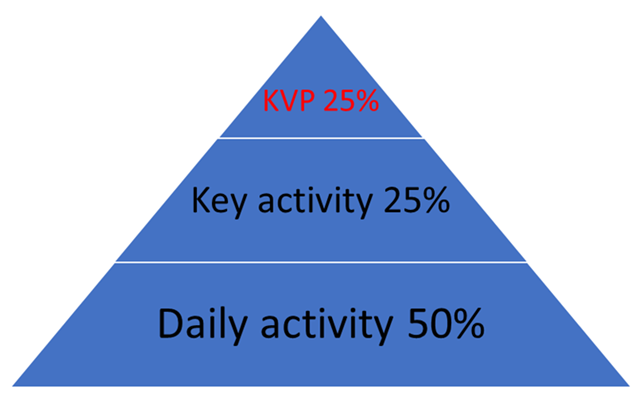
For every hour you invest in them, you will have 3 in return.
How do you do that?
First of all, go back to your organization’s values and find the alignment in the behavior you consider to be the most valuable asset for the time to come.
The second is to schedule and invest the necessary time with these people and use the four magic words: I need your help! Help to be the role model this organization so desperately needs to succeed. Help with attitude, thoughts, and “faith in the future mindset”, both in meetings and in the office corridor.
And third, Let them get an even larger frame with authority and responsibility in your chosen area. For example, holding meetings, being a mentor for employees with potential, and maybe being a part of recruiting new people in your organization.
Many advantages are available when you know how to successfully manage your KVP’s. These are some of them:
– Efficiency increases
– Stronger cultural carriers
– A higher positive mindset
– Wider responsibility and commitment
– Higher chances to fulfill your key objectives
Confidence to choose how best to use our time.

Case study:
One of Scandinavia’s largest customer service departments – which I had in training 6 years ago. They were during one of the first workshops asked to share ideas and develop a method of increasing competence from a broad perspective for the case managers. After they made a list of 12 different methods, they were asked to vote in the group for the most valuable one to use, and schedule as an exercise all over the countries for the time to come. The number one method was maybe the simplest one but also turned out to be the most effective, by looking back at the results. The method which was implemented in all weekly meetings in every country and department was to invest 15 min of the meeting time to share best practice solutions on chosen cases from the previous week. In the beginning, it was a lot of complaining about why doing that and “wasting time”. The results have been astonishing, not in the start, but after a while. They have now 3 Gold medal prizes for best customer service in the last 5 years. And the service manager says that one of the strongest reasons because the exercise of regularly share cases, which they still hold on to weekly. This has built up a higher insight into key values and competence in general. And the performance has dramatically increased all over.

Exercise 1:11
“The best time to plant a tree was 20 years ago. The second-best time is now” – Chinese proverb

Course Manual 12: Value Line (VL)
“A leader is one who knows the way, goes the way, and shows the way” – John Maxwell
In this last lesson, we will run some vital statements to get a value meter on the opinions of your team. One person’s negative perspective on some of the statements may affect the attitude of the whole group, with the risk of razing the organization’s value-based foundation. It’s all too easy to neglect the attitude of your co-workers, which tends to drain you and your organization of energy long-term. The benefit of using a value line bases on vital statements is that it reveals the perspective of your teams on important matters. You’ll also have the possibility to create consensus on your core values, and how they can see it from different angles. In this final course of the workshop, you will discover how to Activate Your team’s consensus and behavior, which will tremendously help you establish a strong culture from your values point of view.
“Cultural differences should not separate us from each other, but rather cultural diversity brings a collective strength that can benefit all of humanity” – Robert Alan

Aligning with values
A value is a principle or quality valuable or desirable. Values are personal; a set of values are so important, that a person just doesn’t feel right when what they are doing conflicts with a value.
Personal stress can come from value conflicts. There is no such thing as a good or wrong set of values, no black or white, only different opinions and different perspective to see things from.
Your values are the things that you consider to be significant in how you live your life and conduct business. They (should) affect your behavior, and they’re used as a steady compass in your life decisions.
Life is better, when the choices you make, and the way you act align with your values. However, things feel “wrong” when these areas do not accord with your values. This can stress people subconsciously. Therefore it is critical to make a conscious choice to define your values.
You align with what you know is right when you examine your values making decisions. You’ll make decisions with confidence and clarity, knowing that you’re making the right decision according to your values.
It’s not easy to make decisions based on values, but it’s always the right thing to do.
Values are also important in determining whom you want to work with within your organization. When you’re getting clear on whom you want to work with and the values you appreciate, you will be of higher service. Putting your values first, in everything you do, will help you to live a life of more happiness and peace.

7 tips for strong Commitment – a necessary ingredient for success.
As a mental coach, you use terms that say as much as possible with the least number of words.
One such is commitment, which I often use because it not only describes how devoted you are, but also contains driving sentences such as motivation and attitude and determination.
Factors that are necessary for success, are about DOING things, not just thinking and pondering and thinking and then postponing, and avoiding to deal with the situation.
Take action!
A challenge that comes from the fact that many feel insecure about the outcome. And start building a story for themselves about why it will not work.
Flip the coin. Do the opposite.
Unleash your potential. Find reasons, and motivation and see the result in front of you. It is the only thing that counts in the end.
Things that separate a mediocre life from a perfect one. A productive from an unproductive. A positive from a negative. Light from darkness. Joy from anxiety.
Some do not like their jobs, or their results, they are dissatisfied. They want to change their lives. They say they want to improve, and strengthen their finances, career, or health.
But they do not read books or articles, do not study their fields, never listen to inspirational clips, do not make any plans, lack ambitions, have no clear gameplan, and do not develop their skills.
They are not committed.
A fruit tree is judged not only by its potential, but by its production. Same thing for us humans. We are primarily judged by what we DO, not by how we think.
Why then are we so afraid to commit? The answer is simple – as it requires delivery. Not just what many use: – I try, which only create escape routes.
Commitment commits.
No excuses accepted. Or as you who have served in the military may learn as point 1 A. SOLVE THE TASK!
Simply.
7 tips for commitment to reach stronger results.
1. Write down your values on paper according to the character matrix. Be as specific as possible. And focus on the behavior you need to build that up.
2. Write down three “why” and the benefits it will give you
3. Find someone who holds you accountable. A high performance coach, who gives you inspiration, and motivation and makes you want to implement.
4. Burn your bridges, minimizing the chances of explanations. Close your escape routes.
5. Take action instead of procrastination. Meet inactivity with activity.
6. Remove obstacles and escape routes and the word “try”. Commit yourself to succeed.
7. Exercise and eat well (at a pace you can handle where you are in life right now). And increase your knowledge step by step – in your field of passion.
Commitment is also about how you use your time. How you spend it tells you the truth.
It is always action that separates people!

Living Your Value
It’s one thing for us to own our value, but it’s a whole separate ability to live it effectively and show it with habits to others.
Let’s consider where we could improve our ability to live our brand and values.
For many of us, this means getting more people on board with the aim to act according to our values. because you’re communicating and acting about something bigger than yourself: a project or your departments or team’s goal.
While we’re focusing on expressing value, each action we do and the commitment we make should help us come closer to the vision we have for it.
What is the worth that I bring to the company, break that down into smaller pieces and think specifically about the value that we express with a customer or within the actual organization.
People relate to the value through shared understanding and behavior. The second component, business benefit, is how we communicate to the organization a shared concept of value.
Few of us have a strategy in place to effectively live the value of what we’re doing and the individuals we’re assisting. That’s why we’re concentrating on it.
Consider the power of more common behavior in the organization:
• Builds security and stability
• Customers and employees are more at ease and happy
• The employee turnover decreases and you kepp competence longer.
• Stronger results in the bottom line.
All of these are benefits.
When we’re greater at executing the work according to our common values, we are in the game long termly.
4 Steps to acting according to your values
1. Identify (in your own mind) what you know that can assist others. What’s your unique value proposition? The companies values and your own character matrix.
2. Ignore the voice in your head. Such as, I’m not ready, I’m not good enough, I’m not smart enough. This is not the truth!
3. Focus on the benefits your behavior provides for the company.
4. Write down evidence of your wins.
It’s not simply about demonstrating our skills or competence when we share and acting according to our values with the world…it’s all about helping and strengthen people. It’s all about giving and sharing.
It’s time to build a new belief system and assert our authority when it comes to the value we provide!
We want our job and the service we provide to reflect our value, so we can start earning what we’re worth.

Case study:
New Zealand’s company Boost, has as its mission to support others to create positive and lasting impacts. Happiness and productivity go hand in hand. That’s why so many of their clients like to hang out with them at Boost. It’s also why they measure team happiness. It’s part of their quest to become New Zealand’s best place to work.
The values behind their purpose
Boost is known for the collaborative way they work. That’s because they share the same values and the same ideas about the best ways to work together.
Creating Clarity
The first step in clarifying their core values was to go back to the behaviors that demonstrate the values. What were the positive ways the team behaved with each other and with clients? And what past behaviors had created frictions that showed they ran counter to their shared values?
Their leadership team used a process to move from behaviors to values. Working silently, they wrote down each behavior they’d seen on a post-it. Once everyone had finished noting behaviors, they stuck the post-it’s on a whiteboard, reading them out and clarifying as required. Next, they grouped like with like. Once the groupings were clear, they were given a label that summed up the core value the behaviors represented.
The next step was to craft descriptions of the core values based on the behaviors. These descriptions needed to be authentic, relatable, and concrete.
Ensuring authenticity
They then shared the draft values with the wider team for feedback.
This started with a whole-team meeting. Their CEO explained what core values are and what they aren’t, why Boost wants to be clear about them, and why we were revisiting them. They then discussed the values the leadership team had come up with.
These were then posted prominently on the wall with space for feedback, suggestions, and questions.
Once the whole team had had a chance to have input into the values, they shared the final versions, adding them to the handbook that all Boosters receive.
• Courage
• Responsibility
• Servant leadership
• Welcoming
With everyone pushing in the same direction, they reinforce their progress as they go, building ever greater momentum.
They got this clarity by answering six questions:
1. Why do we exist?
2. How do we behave?
3. What do we do?
4. How will we succeed?
5. What is most important, right now?
6. Who must do what?
In 2019, they won the Team Gold Award.
This award recognizes the initiatives they’ve introduced in their mission to make Boost the best place to work in New Zealand, initiatives guided and made possible by their shared values.
Measuring the value of core values
As part of their drive to make Boost the best place to work in New Zealand, they use surveys how happy the team is at work.
• In the past year, their Team Happiness rating hit its highest point ever.
They are also seeing increases in their capacity to help others have a positive and lasting impact and in their productivity. This year they have:
• Grown their team by 16%
• increased net profit by 53%.
They survey the team to check that they are staying true to our core values (all answers are anonymous).
• In the most recent survey, 100% agreed we stay true to our values.

Exercise 1:12 Value Line

In summary:
Our life will often feel pointless if we don’t have any ambitions, goals, or values which align with our hearts. Get out there and see what life has in store for you. Do not cling to the past or the future; instead, live in the now and decide what you want to do today.With your values as your compass to lead your way forward.
Listen to your intuition, your inner knowing, and you’ll arrive at the exact location where you’re supposed to be!
It’s important to always assess and ask yourself – Do I want to be happy, or not happy? What changes do I need to make in order to get what I really want? work your way to your own unique path. You have everything you need inside you. Accept yourself, love yourself and make sure to keep moving forward, no matter the circumstances. It’s always action that separates people!
Project Studies
Project Study (Part 1) – Customer Service
The Head of this Department is to provide a detailed report relating to the Value-Based Leadership process that has been implemented within their department, together with all key stakeholders, as a result of conducting this workshop, incorporating process: planning; development; implementation; management; and review. Your process should feature the following 12 parts:
01. Organization Culture (OC)
02. Character Matrix (CM)
03. Confidence Ladder (CL)
04. Are-Can-Do (ACD)
05. Most Important Task (MIT)
06. Facts & Feelings (F&F)
07. Four S’s (4*S)
08. “Same Color of The Shirts” (SCOTS)
09. Attitude Indicator (AI)
10. Setting Large Frames (SLF)
11. Key Value Performers
12. Value Line (VL)
Please include the results of the initial evaluation and assessment.
Project Study (Part 2) – E-Business
The Head of this Department is to provide a detailed report relating to the Value-Based Leadership process that has been implemented within their department, together with all key stakeholders, as a result of conducting this workshop, incorporating process: planning; development; implementation; management; and review. Your process should feature the following 12 parts:
01. Organization Culture (OC)
02. Character Matrix (CM)
03. Confidence Ladder (CL)
04. Are-Can-Do (ACD)
05. Most Important Task (MIT)
06. Facts & Feelings (F&F)
07. Four S’s (4*S)
08. “Same Color of The Shirts” (SCOTS)
09. Attitude Indicator (AI)
10. Setting Large Frames (SLF)
11. Key Value Performers
12. Value Line (VL)
Please include the results of the initial evaluation and assessment.
Project Study (Part 3) – Finance
The Head of this Department is to provide a detailed report relating to the Value-Based Leadership process that has been implemented within their department, together with all key stakeholders, as a result of conducting this workshop, incorporating process: planning; development; implementation; management; and review. Your process should feature the following 12 parts:
01. Organization Culture (OC)
02. Character Matrix (CM)
03. Confidence Ladder (CL)
04. Are-Can-Do (ACD)
05. Most Important Task (MIT)
06. Facts & Feelings (F&F)
07. Four S’s (4*S)
08. “Same Color of The Shirts” (SCOTS)
09. Attitude Indicator (AI)
10. Setting Large Frames (SLF)
11. Key Value Performers
12. Value Line (VL)
Please include the results of the initial evaluation and assessment.
Project Study (Part 4) – Globalization
The Head of this Department is to provide a detailed report relating to the Value-Based Leadership process that has been implemented within their department, together with all key stakeholders, as a result of conducting this workshop, incorporating process: planning; development; implementation; management; and review. Your process should feature the following 12 parts:
01. Organization Culture (OC)
02. Character Matrix (CM)
03. Confidence Ladder (CL)
04. Are-Can-Do (ACD)
05. Most Important Task (MIT)
06. Facts & Feelings (F&F)
07. Four S’s (4*S)
08. “Same Color of The Shirts” (SCOTS)
09. Attitude Indicator (AI)
10. Setting Large Frames (SLF)
11. Key Value Performers
12. Value Line (VL)
Please include the results of the initial evaluation and assessment.
Project Study (Part 5) – Human Resources
The Head of this Department is to provide a detailed report relating to the Value-Based Leadership process that has been implemented within their department, together with all key stakeholders, as a result of conducting this workshop, incorporating process: planning; development; implementation; management; and review. Your process should feature the following 12 parts:
01. Organization Culture (OC)
02. Character Matrix (CM)
03. Confidence Ladder (CL)
04. Are-Can-Do (ACD)
05. Most Important Task (MIT)
06. Facts & Feelings (F&F)
07. Four S’s (4*S)
08. “Same Color of The Shirts” (SCOTS)
09. Attitude Indicator (AI)
10. Setting Large Frames (SLF)
11. Key Value Performers
12. Value Line (VL)
Please include the results of the initial evaluation and assessment.
Project Study (Part 6) – Information Technology
The Head of this Department is to provide a detailed report relating to the Value-Based Leadership process that has been implemented within their department, together with all key stakeholders, as a result of conducting this workshop, incorporating process: planning; development; implementation; management; and review. Your process should feature the following 12 parts:
01. Organization Culture (OC)
02. Character Matrix (CM)
03. Confidence Ladder (CL)
04. Are-Can-Do (ACD)
05. Most Important Task (MIT)
06. Facts & Feelings (F&F)
07. Four S’s (4*S)
08. “Same Color of The Shirts” (SCOTS)
09. Attitude Indicator (AI)
10. Setting Large Frames (SLF)
11. Key Value Performers
12. Value Line (VL)
Please include the results of the initial evaluation and assessment.
Project Study (Part 7) – Legal
The Head of this Department is to provide a detailed report relating to the Value-Based Leadership process that has been implemented within their department, together with all key stakeholders, as a result of conducting this workshop, incorporating process: planning; development; implementation; management; and review. Your process should feature the following 12 parts:
01. Organization Culture (OC)
02. Character Matrix (CM)
03. Confidence Ladder (CL)
04. Are-Can-Do (ACD)
05. Most Important Task (MIT)
06. Facts & Feelings (F&F)
07. Four S’s (4*S)
08. “Same Color of The Shirts” (SCOTS)
09. Attitude Indicator (AI)
10. Setting Large Frames (SLF)
11. Key Value Performers
12. Value Line (VL)
Please include the results of the initial evaluation and assessment.
Project Study (Part 8) – Management
The Head of this Department is to provide a detailed report relating to the Value-Based Leadership process that has been implemented within their department, together with all key stakeholders, as a result of conducting this workshop, incorporating process: planning; development; implementation; management; and review. Your process should feature the following 12 parts:
01. Organization Culture (OC)
02. Character Matrix (CM)
03. Confidence Ladder (CL)
04. Are-Can-Do (ACD)
05. Most Important Task (MIT)
06. Facts & Feelings (F&F)
07. Four S’s (4*S)
08. “Same Color of The Shirts” (SCOTS)
09. Attitude Indicator (AI)
10. Setting Large Frames (SLF)
11. Key Value Performers
12. Value Line (VL)
Please include the results of the initial evaluation and assessment.

Project Study (Part 9) – Marketing
The Head of this Department is to provide a detailed report relating to the Value-Based Leadership process that has been implemented within their department, together with all key stakeholders, as a result of conducting this workshop, incorporating process: planning; development; implementation; management; and review. Your process should feature the following 12 parts:
01. Organization Culture (OC)
02. Character Matrix (CM)
03. Confidence Ladder (CL)
04. Are-Can-Do (ACD)
05. Most Important Task (MIT)
06. Facts & Feelings (F&F)
07. Four S’s (4*S)
08. “Same Color of The Shirts” (SCOTS)
09. Attitude Indicator (AI)
10. Setting Large Frames (SLF)
11. Key Value Performers
12. Value Line (VL)
Please include the results of the initial evaluation and assessment.

Project Study (Part 10) – Production
The Head of this Department is to provide a detailed report relating to the Value-Based Leadership process that has been implemented within their department, together with all key stakeholders, as a result of conducting this workshop, incorporating process: planning; development; implementation; management; and review. Your process should feature the following 12 parts:
01. Organization Culture (OC)
02. Character Matrix (CM)
03. Confidence Ladder (CL)
04. Are-Can-Do (ACD)
05. Most Important Task (MIT)
06. Facts & Feelings (F&F)
07. Four S’s (4*S)
08. “Same Color of The Shirts” (SCOTS)
09. Attitude Indicator (AI)
10. Setting Large Frames (SLF)
11. Key Value Performers
12. Value Line (VL)
Please include the results of the initial evaluation and assessment.

Project Study (Part 11) – Logistics
The Head of this Department is to provide a detailed report relating to the Value-Based Leadership process that has been implemented within their department, together with all key stakeholders, as a result of conducting this workshop, incorporating process: planning; development; implementation; management; and review. Your process should feature the following 12 parts:
01. Organization Culture (OC)
02. Character Matrix (CM)
03. Confidence Ladder (CL)
04. Are-Can-Do (ACD)
05. Most Important Task (MIT)
06. Facts & Feelings (F&F)
07. Four S’s (4*S)
08. “Same Color of The Shirts” (SCOTS)
09. Attitude Indicator (AI)
10. Setting Large Frames (SLF)
11. Key Value Performers
12. Value Line (VL)
Please include the results of the initial evaluation and assessment.

Project Study (Part 12) – Education
The Head of this Department is to provide a detailed report relating to the Value-Based Leadership process that has been implemented within their department, together with all key stakeholders, as a result of conducting this workshop, incorporating process: planning; development; implementation; management; and review. Your process should feature the following 12 parts:
01. Organization Culture (OC)
02. Character Matrix (CM)
03. Confidence Ladder (CL)
04. Are-Can-Do (ACD)
05. Most Important Task (MIT)
06. Facts & Feelings (F&F)
07. Four S’s (4*S)
08. “Same Color of The Shirts” (SCOTS)
09. Attitude Indicator (AI)
10. Setting Large Frames (SLF)
11. Key Value Performers
12. Value Line (VL)
Please include the results of the initial evaluation and assessment.
Program Benefits
Management
- Increased courage
- Leadership excellence
- Vital influence
- Time management
- Empowered employees
- Change management
- Improved communication
- Awareness
- Decision toolkit
- Predictive insights
Human Resources
- Value-based leadership
- Increased collaboration
- Conflict management
- Process improvement
- Mental efficiency
- Employee satisfaction
- Supportive culture
- Shared objectives
- Team synergy
- Embracing change
Sales
- Increased productivity
- Presentation skills
- Argumentation
- Negotiation & closure
- Effective focus
- Stronger resilience
- Improve retention
- Strengthen engagement
- Value proposition
- Clarity
Client Telephone Conference (CTC)
If you have any questions or if you would like to arrange a Client Telephone Conference (CTC) to discuss this particular Unique Consulting Service Proposition (UCSP) in more detail, please CLICK HERE.






















